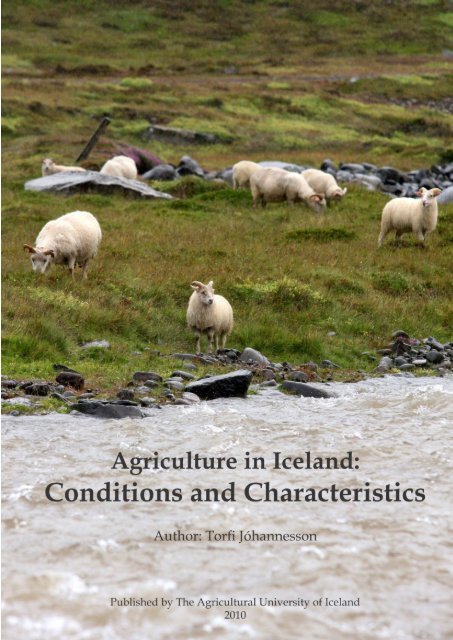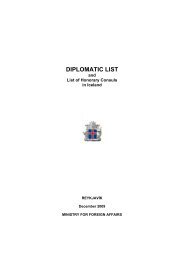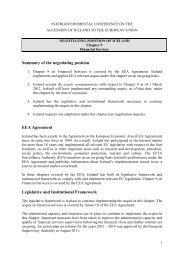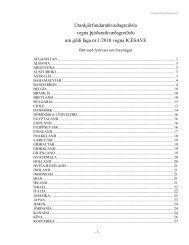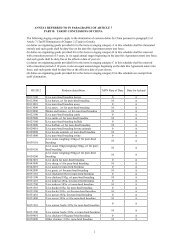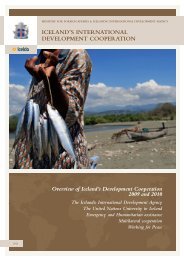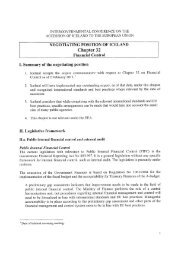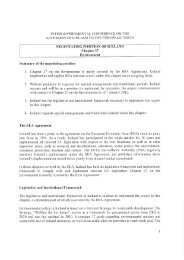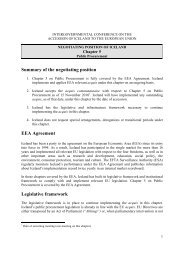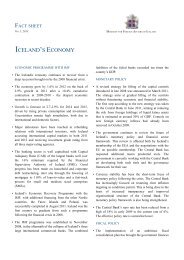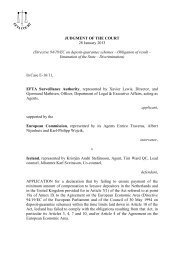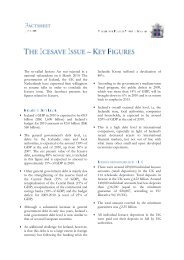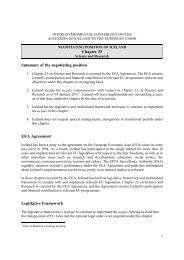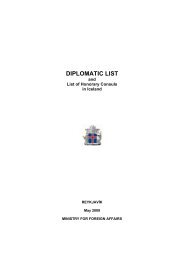Agriculture in Iceland: Conditions and Characteristics - Iceland's ...
Agriculture in Iceland: Conditions and Characteristics - Iceland's ...
Agriculture in Iceland: Conditions and Characteristics - Iceland's ...
Create successful ePaper yourself
Turn your PDF publications into a flip-book with our unique Google optimized e-Paper software.
Special characteristics of <strong>Icel<strong>and</strong></strong>ic <strong>Agriculture</strong><br />
Contents<br />
1 Population, geography <strong>and</strong> natural characteristics ................................................................... 3<br />
1.1 Population <strong>and</strong> geographical statistics .............................................................................. 3<br />
1.2 Natural conditions .............................................................................................................. 5<br />
1.3 Climate ............................................................................................................................... 6<br />
1.4 Natural hazards .................................................................................................................. 8<br />
2 <strong>Icel<strong>and</strong></strong>ic <strong>Agriculture</strong> ................................................................................................................... 8<br />
2.1 Historical overview ............................................................................................................. 8<br />
2.2 Livestock production .......................................................................................................... 9<br />
2.2.1 Disease comparison ................................................................................................. 15<br />
2.2.2 Dairy <strong>and</strong> beef production ....................................................................................... 15<br />
2.2.3 Sheep production ..................................................................................................... 17<br />
2.2.4 Pigs <strong>and</strong> poultry ........................................................................................................ 20<br />
2.2.5 Other livestock production....................................................................................... 21<br />
2.3 Crop production ............................................................................................................... 22<br />
2.3.1 Pesticides <strong>and</strong> fertilizer ............................................................................................ 23<br />
2.3.2 Organic production .................................................................................................. 24<br />
2.3.3 Conclusion ................................................................................................................ 24<br />
2.4 Horticulture ...................................................................................................................... 25<br />
2.5 Forestry ............................................................................................................................ 25<br />
2.6 Aquaculture ...................................................................................................................... 26<br />
2.7 F<strong>in</strong>al remarks .................................................................................................................... 27<br />
2.8 References ........................................................................................................................ 29<br />
2
Special characteristics of <strong>Icel<strong>and</strong></strong>ic <strong>Agriculture</strong><br />
1 Population, geography <strong>and</strong> natural characteristics<br />
1.1 Population <strong>and</strong> geographical statistics<br />
The population of <strong>Icel<strong>and</strong></strong> is approximately 317.000 1 , smaller than any of EU member states,<br />
although similar to the population of Malta. The overwhelm<strong>in</strong>g majority of the population lives on<br />
the ma<strong>in</strong> isl<strong>and</strong>, which is about 103.000 km 2 but a few thous<strong>and</strong> <strong>in</strong>habit 3-4 small isl<strong>and</strong>s close to<br />
the coast. Approximately quarter of the l<strong>and</strong> is below 200 m <strong>and</strong> all major settlements as well as<br />
most agricultural production are to be found <strong>in</strong> those locations. The geographical size of <strong>Icel<strong>and</strong></strong> is<br />
close to the median of European countries along with Portugal, Hungary <strong>and</strong> Bulgaria (see Table<br />
1).<br />
Table 1. Population, area <strong>and</strong> population density of European countries <strong>and</strong> selected regions.<br />
Country/Region Population 1 Area 2 Population density<br />
km 2 (<strong>in</strong>habitants per km²) 3<br />
Germany 82.314.906 357.114 229,9<br />
France 63.623.209 632.834 100,9<br />
United K<strong>in</strong>gdom 60.781.352 242.900 250,8<br />
Italy 59.131.287 301.336 201,2<br />
Spa<strong>in</strong> 44.474.631 505.992 87,9*)<br />
Pol<strong>and</strong> 38.125.479 312.685 121,9<br />
Romania 21.565.119 238.391 93,7<br />
Netherl<strong>and</strong>s 16.357.992 37.354 485,3<br />
Greece 11.171.740 131.957 85,6<br />
Portugal 10.599.095 92.090 115,2<br />
Belgium 10.584.534 30.528 350,4<br />
Czech Republic 10.287.189 78.867 133,8<br />
Hungary 10.066.158 93.028 108,1<br />
Sweden 9.113.257 441.370 22,3<br />
Austria 8.282.984 83.871 98,8<br />
Bulgaria 7.679.290 110.879 69,0<br />
Switzerl<strong>and</strong> 7.508.739 41.284 188,8<br />
Denmark 5.447.084 43.094 126,7<br />
Slovakia 5.393.637 49.034 110,1<br />
F<strong>in</strong>l<strong>and</strong> 5.276.955 338.419 17,4<br />
Norway**) 4.681.134 323.802 15,5<br />
Croatia 4.441.238 56.594 78,5<br />
Irel<strong>and</strong> 4.312.526 70.273 63,7<br />
Lithuania 3.384.879 65.300 53,9<br />
Latvia 2.281.305 65.449 36,5<br />
FYR Macedonia 2.041.941 25.713 82,0<br />
Slovenia 2.010.377 20.273 100,2<br />
Estonia 1.342.409 45.227 30,9<br />
1 Jan 1, 2010.<br />
3
Special characteristics of <strong>Icel<strong>and</strong></strong>ic <strong>Agriculture</strong><br />
Cyprus 778.684 9.251 84,2<br />
Luxembourg 476.187 2.586 184,1<br />
Northern-Norway*** ) 462.237 112.948 4,3<br />
Highl<strong>and</strong>s <strong>and</strong> Isl<strong>and</strong>s UK 442.400 39.500 11,2<br />
Malta 407.810 316 1.290,5<br />
<strong>Icel<strong>and</strong></strong> 307.672 103.000 3,1<br />
Fr. Guiana 213.031 83.534 2,6<br />
Liechtenste<strong>in</strong> 35.168 160 219,8<br />
*) Numbers <strong>in</strong> italic were miss<strong>in</strong>g <strong>in</strong> the orig<strong>in</strong>al datasets but are calculated on basis of the numbers <strong>in</strong> the<br />
two other columns.<br />
**) Without Svalbard <strong>and</strong> Jan Mayen, which are 62.422 km 2<br />
***) Northern Norway: F<strong>in</strong>nmark, Norl<strong>and</strong> <strong>and</strong> Troms.<br />
The population density is extremely low; 3.1 <strong>in</strong>habitants/km 2 , compared to 112 <strong>in</strong>habitants/km 2 <strong>in</strong><br />
EU-27. Even the Sc<strong>and</strong><strong>in</strong>avian countries Norway, F<strong>in</strong>l<strong>and</strong> <strong>and</strong> Sweden are several magnitudes<br />
above <strong>Icel<strong>and</strong></strong> with 15-22 <strong>in</strong>habitants/km 2 . To f<strong>in</strong>d comparable densities one has to go to regional<br />
levels where French Guiana <strong>and</strong> a few of the northern most regions of F<strong>in</strong>l<strong>and</strong>, Sweden <strong>and</strong><br />
Norway 4 have a population density close to <strong>Icel<strong>and</strong></strong> (see Table 1).<br />
Almost 80% of the <strong>Icel<strong>and</strong></strong>ic nation lives <strong>in</strong> the south west corner of the country; <strong>in</strong> or close to the<br />
capital area. This means, that for most of the agricultural areas, population density is well below<br />
the country average (as seen <strong>in</strong> Figure 1).<br />
Figure 1. Population density below 200 m, divided by municipalities 5 .<br />
The small population size <strong>and</strong> considerable dispersion have widespread implications for<br />
agricultural production <strong>in</strong> <strong>Icel<strong>and</strong></strong>:<br />
<br />
<br />
The local market is small so it is very difficult for the process<strong>in</strong>g <strong>in</strong>dustry to ga<strong>in</strong> from the<br />
benefit of scale <strong>and</strong> the <strong>in</strong>dustry produces a wide range <strong>in</strong> very small quantities.<br />
Transport cost is high, both for live animals (<strong>and</strong> raw milk) from farmers to the process<strong>in</strong>g<br />
plants, but also of processed food from the plants to consumers.<br />
4
Special characteristics of <strong>Icel<strong>and</strong></strong>ic <strong>Agriculture</strong><br />
<br />
<br />
Centralized services, like technical service, farm extension service <strong>and</strong> health <strong>in</strong>spection is<br />
bound to be scattered <strong>in</strong> small, often <strong>in</strong>efficient units. Each unit only serves relatively few<br />
farmers but has nonetheless large distances to cover.<br />
The retail market is dom<strong>in</strong>ated by few companies, which means that the farm<strong>in</strong>g <strong>in</strong>dustry<br />
has a weak position aga<strong>in</strong>st the retail <strong>in</strong>dustry. This would be especially critical if import<br />
restrictions were removed.<br />
Taken together, the unique demographical conditions <strong>in</strong> <strong>Icel<strong>and</strong></strong> result <strong>in</strong> vulnerable <strong>and</strong> noncompetitive<br />
agricultural <strong>in</strong>dustry.<br />
1.2 Natural conditions<br />
<strong>Icel<strong>and</strong></strong> lies <strong>in</strong> the North Atlantic, just south of the Arctic Circle between the latitudes 63.2° N <strong>and</strong><br />
66.3°N. The shortest distance to neighbour<strong>in</strong>g countries is 290 km to Greenl<strong>and</strong>; 800 km to<br />
Scotl<strong>and</strong> <strong>and</strong> 970 km to Norway 6 .<br />
Most of the centre of the country is un<strong>in</strong>habited highl<strong>and</strong> <strong>and</strong> most of the farm<strong>in</strong>g is located <strong>in</strong><br />
the deep valleys of the north <strong>and</strong> the southern lowl<strong>and</strong>s. Due to the volcanic activity of <strong>Icel<strong>and</strong></strong>,<br />
soil is ample <strong>in</strong> the lowl<strong>and</strong>s but the composition of the soil is rather unique. Accord<strong>in</strong>g to the<br />
<strong>Icel<strong>and</strong></strong>ic Classification System, soils <strong>in</strong> <strong>Icel<strong>and</strong></strong> are dom<strong>in</strong>ated by Andosols when covered by<br />
vegetation, Vitrisols <strong>in</strong> deserted areas <strong>and</strong> the highly organic Histosols <strong>in</strong> some wetl<strong>and</strong> areas 7 .<br />
The Andosols are characterized by high organic content <strong>and</strong> water hold<strong>in</strong>g capacity but a general<br />
lack of cohesion. This means, that if the vegetation is weakened (e.g. by overgraz<strong>in</strong>g) these soils<br />
are vulnerable to erosion by water or w<strong>in</strong>d. Additionally, the <strong>Icel<strong>and</strong></strong>ic flora is mostly lack<strong>in</strong>g<br />
nitrogen fixat<strong>in</strong>g plants, although e.g. the Nootka lup<strong>in</strong>e has been imported from Alaska. This fact<br />
might add to the vulnerability of the <strong>Icel<strong>and</strong></strong>ic vegetation.<br />
At the time of settlement, approximately 60% of <strong>Icel<strong>and</strong></strong> was vegetated <strong>and</strong> some 15-20% covered<br />
by forest. By now, however, only 27% of the country is vegetated <strong>and</strong> natural forest only covers<br />
about 1% of the total area 8 .<br />
Figure 2 shows a map of l<strong>and</strong> degradation <strong>in</strong> <strong>Icel<strong>and</strong></strong>. Accord<strong>in</strong>g to this classification 40% of the<br />
isl<strong>and</strong> is “considerably”, “severely” or “extremely” eroded 9 .<br />
5<br />
Figure 2. Soil erosion <strong>in</strong> <strong>Icel<strong>and</strong></strong>.
Special characteristics of <strong>Icel<strong>and</strong></strong>ic <strong>Agriculture</strong><br />
Soil erosion <strong>in</strong> <strong>Icel<strong>and</strong></strong> has been systematically fought s<strong>in</strong>ce the establishment of The Soil<br />
Conservation Service (SCS) <strong>in</strong> 1907. First, by stopp<strong>in</strong>g widespread s<strong>and</strong> storms <strong>in</strong> the southern<br />
cost of <strong>Icel<strong>and</strong></strong>, but later by extensive sow<strong>in</strong>g of Leymus grass, Lup<strong>in</strong>e <strong>and</strong> several other native <strong>and</strong><br />
imported plants. In 1990 the SCS started work<strong>in</strong>g systematically with farmers, yield<strong>in</strong>g f<strong>in</strong>ancial<br />
<strong>in</strong>centives <strong>and</strong> technical/scientific support to encourage l<strong>and</strong> restoration projects. Currently 650<br />
farmers are participat<strong>in</strong>g <strong>in</strong> this program 10 .<br />
1.3 Climate<br />
Despite northern location, temperature <strong>in</strong> <strong>Icel<strong>and</strong></strong> is relatively mild <strong>in</strong> w<strong>in</strong>ter due to the Gulf<br />
Stream, br<strong>in</strong>g<strong>in</strong>g warm sea from the south. There is, however, a considerable difference between<br />
south west <strong>and</strong> north east, the former mild <strong>and</strong> wet but the latter with the character of<br />
cont<strong>in</strong>ental climate <strong>and</strong> weather conditions <strong>in</strong> general can be extremely unstable (see Table 2).<br />
Table 2. Long term 11 average temperature <strong>and</strong> annual precipitation different European places. If not otherwise<br />
<strong>in</strong>dicated, data are from http://www.worldweather.org/europe.htm<br />
Jan<br />
July<br />
City<br />
Daily<br />
m<strong>in</strong> °C<br />
Daily<br />
max °C<br />
Daily<br />
m<strong>in</strong> °C<br />
Daily<br />
max °C<br />
Annual<br />
precipitation (mm)<br />
Reykjavik a) (lat. 64.4 N) -3.0 1.9 8.3 11.3 799 12<br />
Ed<strong>in</strong>burgh b) (55.6 N) 0.3 6.2 10.3 18.8 676 13<br />
Hels<strong>in</strong>ki b) (lat. 60.1 N) -8.5 -2.6 11.8 21.8 642 14<br />
Rovaniemi b) (lat. 66.5 N) -15.1 -8.5 11.0 19.4 577<br />
Tromsø a) (lat. 69.6 N) -6.5 -2.2 8.7 15.3 1031 15<br />
Brussels b) (lat. 50.5 N) 0.7 5.6 13.6 22.4 821 16<br />
Vienna (lat. 48.1 N) 17 -2.0 -1.0 15.4 25.6 607 18<br />
a) Data from 1961-1990; b) Data from 1971-2000<br />
The most strik<strong>in</strong>g difference between the <strong>Icel<strong>and</strong></strong>ic locations <strong>and</strong> those on ma<strong>in</strong>l<strong>and</strong> Europe is the<br />
unusually low summer temperature. This low temperature considerably limits the grow<strong>in</strong>g<br />
potential for a range of agricultural plants both which plants can be grown <strong>and</strong> their yield.<br />
Another difference, not apparent from Table 2, is the highly fluctuat<strong>in</strong>g climate with temperatures<br />
repeatedly dropp<strong>in</strong>g (or ris<strong>in</strong>g) 10-20°C with<strong>in</strong> a day.<br />
Grow<strong>in</strong>g degree-days is another recognized parameter for compar<strong>in</strong>g cultivation conditions<br />
between countries. Figure 3 shows the Accumulated Day Degrees <strong>in</strong> few northern cities,<br />
calculated on the basis of monthly temperature averages from April to September.<br />
6
Special characteristics of <strong>Icel<strong>and</strong></strong>ic <strong>Agriculture</strong><br />
Figure 3. Accumulated Day Degrees (ADD) based on monthly temperature averages 19 .<br />
The figure shows clearly how Reykjavik, along with Tromsø is far lower than e.g. central Norway<br />
<strong>and</strong> Scotl<strong>and</strong>, result<strong>in</strong>g <strong>in</strong> a permanent h<strong>and</strong>icap for gra<strong>in</strong> production.<br />
Taken together, climate <strong>and</strong> soil conditions impose several limitations on farm<strong>in</strong>g <strong>in</strong> <strong>Icel<strong>and</strong></strong>.<br />
Figure 4 shows recent classification of the country based on cultivation zones. Some of the areas<br />
with relatively mild climate are covered with lava or s<strong>and</strong> (red diagonal l<strong>in</strong>es) further limit<strong>in</strong>g the<br />
potential l<strong>and</strong> use.<br />
Figure 4. Map of <strong>Icel<strong>and</strong></strong> patterned accord<strong>in</strong>g to cultivation zones. Zone A is best suited for cultivation while<br />
zone D <strong>in</strong>cludes the natural limits for forest growth 20 .<br />
7
Special characteristics of <strong>Icel<strong>and</strong></strong>ic <strong>Agriculture</strong><br />
1.4 Natural hazards<br />
The most common natural hazards for agricultural production are related to extreme weather<br />
conditions. An example of this is a 35% loss <strong>in</strong> the annual potato harvest <strong>in</strong> 2009, as the result of<br />
repeated night frosts <strong>in</strong> July <strong>and</strong> August 21 . Another famous example was April 16 1963 when<br />
temperature <strong>in</strong> Southern <strong>Icel<strong>and</strong></strong> dropped almost 20 degrees with<strong>in</strong> a day caus<strong>in</strong>g widespread <strong>and</strong><br />
permanent damage on Populus trees <strong>in</strong> large part of the country 22 . In any case, temperatures<br />
below zero can be expected <strong>in</strong> most summer months every few years 23 <strong>and</strong> have repeatedly<br />
caused damage to vegetables, potatoes <strong>and</strong> barley.<br />
Extreme w<strong>in</strong>d is quite common <strong>in</strong> <strong>Icel<strong>and</strong></strong>. Table 3 shows examples of w<strong>in</strong>d measurements <strong>in</strong> the<br />
capital region. W<strong>in</strong>d speed of more than 30 m/s is to be expected <strong>in</strong> most w<strong>in</strong>ters <strong>and</strong> <strong>in</strong> many<br />
places w<strong>in</strong>d speed of more than 60 m/s is not uncommon. Strong w<strong>in</strong>ds <strong>in</strong> autumn can be<br />
particularly hazardous for gra<strong>in</strong> production caus<strong>in</strong>g sizable losses prior to harvest.<br />
Table 3. W<strong>in</strong>d measurements <strong>in</strong> Kjalarnes (2001-2006) <strong>and</strong> Reykjavik airport (2006-2007).<br />
Month Kjalarnes 24 Reykjavik airport 25<br />
Percentage of obs.<br />
with w<strong>in</strong>d burst ><br />
30 m/s<br />
Highest w<strong>in</strong>d<br />
burst (m/s)<br />
Average w<strong>in</strong>d<br />
speed (m/s)<br />
Highest w<strong>in</strong>d<br />
burst (m/s)<br />
Jan 5,1% 49,7 5,3 25,9<br />
Jul 0,05% 31,5 3,9 20,7<br />
Floods <strong>in</strong> certa<strong>in</strong> rivers can be expected on a regular basis, but the effects are usually limited to<br />
relatively few farms.<br />
Volcanic eruptions <strong>and</strong> earthquakes are a real threat for agriculture <strong>in</strong> <strong>Icel<strong>and</strong></strong>, as clearly<br />
demonstrated <strong>in</strong> the recent eruptions of Eyjafjallajokull 2010. Direct threat from volcanoes<br />
<strong>in</strong>cludes ash, lava <strong>and</strong> flood<strong>in</strong>g <strong>in</strong> glacial rivers but <strong>in</strong>direct effects can be transportation problems,<br />
high build<strong>in</strong>g cost <strong>and</strong> general <strong>in</strong>security. The eruption <strong>in</strong> Eyjafjallajokull resulted <strong>in</strong> direct damage<br />
of agricultural l<strong>and</strong> <strong>and</strong> hold<strong>in</strong>gs of €1.900.000 26 . It should be noted, that weather conditions<br />
were exceptionally favourable as most of the ash was blown direct South of the country. Different<br />
weather conditions would have had severe effects on productive agricultural areas <strong>in</strong> S-<strong>Icel<strong>and</strong></strong>.<br />
In 2008 a earthquake of 6,3 on the Richter scale hit the southern lowl<strong>and</strong> <strong>and</strong> resulted <strong>in</strong> a total<br />
loss of €35 mill. <strong>and</strong> another slightly smaller earthquake took place <strong>in</strong> 2000. In historical times<br />
volcanic eruptions <strong>and</strong> earthquakes have repeatedly caused great damage but the worst example<br />
is the eruption of Laki <strong>in</strong> 1783-1785 which left 80% of <strong>Icel<strong>and</strong></strong>ic livestock <strong>and</strong> 20% of the human<br />
population <strong>in</strong> va<strong>in</strong> 27 .<br />
2 <strong>Icel<strong>and</strong></strong>ic <strong>Agriculture</strong><br />
2.1 Historical overview<br />
<strong>Icel<strong>and</strong></strong> was settled between 800 <strong>and</strong> 1000 AD 28 , mostly by Norwegians that brought with them<br />
the culture of Sc<strong>and</strong><strong>in</strong>avian farm<strong>in</strong>g. Helgadottir <strong>and</strong> Sve<strong>in</strong>sson 29 offer concise historical review of<br />
<strong>Icel<strong>and</strong></strong>ic agriculture from settlement to the 20 th century:<br />
8<br />
The development of agriculture <strong>in</strong> <strong>Icel<strong>and</strong></strong> from the time of the settlement <strong>in</strong> the late n<strong>in</strong>th<br />
century to the present day can be divided <strong>in</strong>to five dist<strong>in</strong>ct phases which are reflected <strong>in</strong><br />
the production of farm produce … :<br />
I: 900-1900 Self-sufficiency<br />
For centuries sheep husb<strong>and</strong>ry was the ma<strong>in</strong> farm<strong>in</strong>g activity <strong>in</strong> <strong>Icel<strong>and</strong></strong> <strong>and</strong> productivity<br />
was very low. Hay was made up of <strong>in</strong>digenous species obta<strong>in</strong>ed from wild pastures <strong>and</strong><br />
bog l<strong>and</strong>s. It has been estimated that the country could carry 360 thous<strong>and</strong> sheep by
Special characteristics of <strong>Icel<strong>and</strong></strong>ic <strong>Agriculture</strong><br />
utiliz<strong>in</strong>g graz<strong>in</strong>g all year round <strong>and</strong> hay obta<strong>in</strong>ed from bogs <strong>in</strong> more difficult years. This<br />
was sufficient to ma<strong>in</strong>ta<strong>in</strong> a population of 60 thous<strong>and</strong> (see Guðbergsson 1996).<br />
II. 1900-1945. Cultivation beg<strong>in</strong>s<br />
The grow<strong>in</strong>g urban population created a market for agricultural products. Food security<br />
was the major political driver for agriculture. Farmers adopted new but primitive<br />
technology <strong>in</strong> hay production <strong>and</strong> <strong>in</strong> improvements of hay fields. Artificial fertilizers arrived<br />
on the scene.<br />
III. 1945-1980. Technological advances, <strong>in</strong>creased production<br />
After the end of World War II the rural population decreased rapidly <strong>and</strong> a subsidy system<br />
was set up to reward <strong>in</strong>creased production. Advanced mach<strong>in</strong>ery was imported to reclaim<br />
new agricultural l<strong>and</strong>. <strong>Agriculture</strong> was driven towards extensive cultivation of grassl<strong>and</strong><br />
seeded with <strong>in</strong>troduced non-adapted grass cultivars <strong>and</strong> greater <strong>in</strong>tensification with the<br />
use of artificial fertilizer <strong>and</strong> concentrates. Unfavourable climatic conditions <strong>in</strong> the 1960’s<br />
caused severe w<strong>in</strong>ter kill <strong>in</strong> cultivated grassl<strong>and</strong>s <strong>in</strong> many parts of the country.<br />
IV. 1980-1995. Production restrictions<br />
Overproduction, particularly <strong>in</strong> the sheep sector, called for revision of the extensive subsidy<br />
system. A quota system was <strong>in</strong>troduced <strong>and</strong> farmers had to adapt to production<br />
limitations. A complete revision of the legal framework for agricultural policies was carried<br />
out <strong>in</strong> 1985. The ma<strong>in</strong> objectives were “to promote structural adjustment <strong>and</strong> <strong>in</strong>crease<br />
efficiency <strong>in</strong> agricultural production <strong>and</strong> process<strong>in</strong>g for the benefit of producers <strong>and</strong><br />
consumers <strong>and</strong> to adjust the level of production to domestic dem<strong>and</strong> <strong>and</strong> secure sufficient<br />
supply of agricultural products as far as practicable at all times” (Thorgeirsson 1996).<br />
[it should be added that <strong>in</strong> 1992 all export support <strong>in</strong> agriculture was abolished] 30<br />
IV. 1995-2006. Improved efficiency<br />
Food habits are chang<strong>in</strong>g <strong>and</strong> the proportion of local agricultural products <strong>in</strong> the total<br />
food budget becomes progressively lower. The drive is now towards ma<strong>in</strong>ta<strong>in</strong><strong>in</strong>g marg<strong>in</strong>s<br />
by reduc<strong>in</strong>g <strong>in</strong>puts as well as by <strong>in</strong>creas<strong>in</strong>g outputs. Dairy <strong>and</strong> sheep production is steady<br />
but the number of “traditional” farms is decl<strong>in</strong><strong>in</strong>g, especially <strong>in</strong> the dairy sector. Increas<strong>in</strong>g<br />
urban dem<strong>and</strong> for rural estates is caus<strong>in</strong>g a significant rise <strong>in</strong> farml<strong>and</strong> prices. Farmers <strong>and</strong><br />
other l<strong>and</strong>owners are look<strong>in</strong>g to alternative l<strong>and</strong> uses <strong>in</strong> addition to food production <strong>and</strong><br />
agriculture becomes progressively more multifunctional.<br />
What is of special <strong>in</strong>terest is the prolonged period of self-sufficiency <strong>and</strong> how late farmers were to<br />
start cultivat<strong>in</strong>g their l<strong>and</strong>. Several factors can expla<strong>in</strong> this; lack of iron for tool mak<strong>in</strong>g, low<br />
population density, modest foreign trade <strong>and</strong> generally harsh natural conditions. <strong>Icel<strong>and</strong></strong> did,<br />
however, manage to ma<strong>in</strong>ta<strong>in</strong> self sufficiency of animal products at most times, although the<br />
population has always been dependent on imported gra<strong>in</strong>.<br />
2.2 Livestock production<br />
Agricultural production <strong>in</strong> <strong>Icel<strong>and</strong></strong> is almost entirely animal based (except for horticulture which<br />
will be dealt with <strong>in</strong> a special chapter). Limited amounts of barley are grown, but mostly for<br />
animal fodder <strong>and</strong> still, most gra<strong>in</strong> for fodder is imported.<br />
<strong>Icel<strong>and</strong></strong> has only a s<strong>in</strong>gle breed of dairy cows, a s<strong>in</strong>gle breed of sheep (<strong>and</strong> goats) <strong>and</strong> a s<strong>in</strong>gle<br />
breed of horses. These are all breeds that have rema<strong>in</strong>ed almost completely isolated s<strong>in</strong>ce the<br />
settlement of the isl<strong>and</strong> approximately 1100 years ago.<br />
9
Special characteristics of <strong>Icel<strong>and</strong></strong>ic <strong>Agriculture</strong><br />
Structural statistics Table 4 shows the total number of livestock <strong>in</strong> <strong>Icel<strong>and</strong></strong> <strong>and</strong> most EU-27<br />
countries. <strong>Icel<strong>and</strong></strong> st<strong>and</strong>s for only 0.5% of the total sheep population <strong>in</strong> the EU <strong>and</strong> 0.1% of the<br />
total number of dairy cows.<br />
Table 4. Number of dairy cows, sheep <strong>and</strong> pigs <strong>in</strong> EU countries <strong>and</strong> <strong>Icel<strong>and</strong></strong>. Numbers from the years 2007 <strong>and</strong> 2008<br />
<strong>and</strong> all numbers are <strong>in</strong> thous<strong>and</strong>s.<br />
Country<br />
10<br />
Dairy Sheep 32 Pigs 33<br />
cows 31<br />
Germany 4.229 1.920 27.113<br />
France 3.794 7.715 14.969<br />
Pol<strong>and</strong> 2.697 270 17.621<br />
United K<strong>in</strong>gdom 1.903 21.856 4.671<br />
Italy 1.831 8.175 9.273<br />
Netherl<strong>and</strong>s 1.587 1.545 11.710<br />
Romania 1.483 8.882 6.565<br />
Irel<strong>and</strong> 1.105 3.423 1.575<br />
Spa<strong>in</strong> 888 19.952 26.061<br />
Denmark 566 90 13.170<br />
Austria 530 333 3.286<br />
Belgium 518 : 6.200<br />
Czech Republic 400 183 2.662<br />
Lithuania 395 48 923<br />
Sweden 366 521 1.728<br />
Bulgaria 315 1.475 889<br />
Portugal 301 3.145 2.374<br />
F<strong>in</strong>l<strong>and</strong> 288 94 1.427<br />
Hungary 263 1.236 3.871<br />
Croatia 213 643 1.348<br />
Slovakia 174 362 952<br />
Latvia 170 67 414<br />
Greece 154 8.994 1.038<br />
Slovenia 113 139 543<br />
Estonia 100 62 375<br />
Luxembourg 46 8 86<br />
<strong>Icel<strong>and</strong></strong> 34 26 462 4<br />
Cyprus 24 267 467<br />
Malta 7 13 77<br />
Only Cyprus <strong>and</strong> Malta have fewer dairy cows than <strong>Icel<strong>and</strong></strong> but many countries have fewer sheep,<br />
even though <strong>Icel<strong>and</strong></strong> lies well below the average. The number of pigs <strong>in</strong> <strong>Icel<strong>and</strong></strong>, however, is<br />
exceptionally low; little more than 4000, while the correspond<strong>in</strong>g number for Malta is 77.000.<br />
S<strong>in</strong>ce the mid 1980’s agricultural policy <strong>in</strong> <strong>Icel<strong>and</strong></strong> has aimed at meet<strong>in</strong>g domestic dem<strong>and</strong> for<br />
animal products as production prices are generally too high for large scale export. This has been<br />
accomplished with import restrictions, tariffs, quota system <strong>in</strong> dairy <strong>and</strong> sheep production <strong>and</strong><br />
direct payments to farmers. This system, despite its limitations, has <strong>in</strong>deed succeeded <strong>in</strong> keep<strong>in</strong>g<br />
production <strong>in</strong> relation to domestic sales (Figure 5 <strong>and</strong> Figure 6).
liters milk (millions)<br />
Special characteristics of <strong>Icel<strong>and</strong></strong>ic <strong>Agriculture</strong><br />
Figure 5. Production <strong>and</strong> export of meat <strong>in</strong> <strong>Icel<strong>and</strong></strong> (average numbers 1999-2008) 35 .<br />
Approximately 15-20% of the lamb meat production has though been exported annually for the<br />
last 10-15 years 36 but often as a surplus production, giv<strong>in</strong>g reduced payback to producers. Small<br />
amounts of horse meet have also been exported, mostly to Europe 37 .<br />
130<br />
125<br />
120<br />
115<br />
110<br />
Production<br />
Domestic consumption<br />
105<br />
100<br />
1993 1995 1997 1999 2001 2003 2005 2007 2009<br />
Year<br />
Figure 6. Production <strong>and</strong> domestic consumption of milk <strong>in</strong> <strong>Icel<strong>and</strong></strong> 1994-2008 38 .<br />
On average 3% of the annual dairy production 2006-2009 was exported 39 ; mostly 2 to Europe 40 .<br />
Despite several attempts, no long term market access has been established for <strong>Icel<strong>and</strong></strong>ic milk<br />
products. The export is ma<strong>in</strong>ly <strong>in</strong> the form of butter (544 t <strong>in</strong> 2009) <strong>and</strong> milk powder (528 t) 41 .<br />
Geographically, the animal production is concentrated <strong>in</strong> few regions <strong>in</strong> south, west <strong>and</strong> north<br />
<strong>Icel<strong>and</strong></strong>, as can be seen <strong>in</strong> Figure 7 <strong>and</strong> Figure 8. The figures show the distribution of direct<br />
payments, which are based on annually produced litres. It should be noted though that the<br />
2 67% were exported to Europe on average 2006-2009, based on fob-price.<br />
11
Special characteristics of <strong>Icel<strong>and</strong></strong>ic <strong>Agriculture</strong><br />
correspondence between production <strong>and</strong> direct payments is not 100% but nonetheless, the<br />
figures offer acceptable outl<strong>in</strong>e of the production distribution.<br />
Figure 7. Distribution of direct payments to dairy farmers (numbers <strong>in</strong>dicate million litres) 42 .<br />
The milk production is concentrated around the urban areas <strong>in</strong> South <strong>and</strong> West <strong>Icel<strong>and</strong></strong> as well as<br />
<strong>in</strong> Akureyri region <strong>in</strong> Northern <strong>Icel<strong>and</strong></strong>. This distribution is probably related to distance to the<br />
markets <strong>and</strong> general farm<strong>in</strong>g conditions. The North-West <strong>and</strong> the East of <strong>Icel<strong>and</strong></strong> have very limited<br />
milk production.<br />
The total number of milk producers 2008 was close to 760 but <strong>in</strong> 1993 the number was 1.700 43<br />
giv<strong>in</strong>g an annual decl<strong>in</strong>e of 62 farms on average. The average farm size is 34,4 dairy cows (2008<br />
numbers), compared to 17,6 <strong>in</strong> 1993. These structural changes reflect the technological progress<br />
<strong>and</strong> a liberal market with quota <strong>and</strong> farm l<strong>and</strong>.<br />
12
Special characteristics of <strong>Icel<strong>and</strong></strong>ic <strong>Agriculture</strong><br />
Figure 8. Distribution of direct payments to sheep farmers (numbers <strong>in</strong>dicate slaughter weight) 44 .<br />
The distribution of the sheep production follows somewhat a different path with higher<br />
concentration <strong>in</strong> the more remote areas of North-West <strong>and</strong> North-East. Sheep production <strong>in</strong><br />
<strong>Icel<strong>and</strong></strong> requires considerable areas of extensive grassl<strong>and</strong> for graz<strong>in</strong>g <strong>and</strong> close to the urban<br />
areas, l<strong>and</strong> price is too high.<br />
The number of sheep farms is 2.785 (2008 numbers) 3 compared to 3.286 <strong>in</strong> 1993 37 . The annual<br />
decl<strong>in</strong>e is 33 farms; considerably less than the drop <strong>in</strong> number of dairy producers, but quite<br />
considerable, nonetheless. The difference can partly be expla<strong>in</strong>ed by the fact that many sheep<br />
farms are small <strong>and</strong> contribute only to a part of the total farm <strong>in</strong>come.<br />
Figure 9 shows the changes <strong>in</strong> size distribution of sheep farms <strong>in</strong> <strong>Icel<strong>and</strong></strong> the last 30 years. The<br />
most apparent change is the <strong>in</strong>crease of very small farms <strong>and</strong> also <strong>in</strong>crease <strong>in</strong> the share of large<br />
farms. The medium sized farms, on the other h<strong>and</strong> are los<strong>in</strong>g ground.<br />
3 The numbers are based on the receivers of direct payments <strong>and</strong> might be a slight underestimate as some<br />
small hobby-producers are not registered.<br />
13
Special characteristics of <strong>Icel<strong>and</strong></strong>ic <strong>Agriculture</strong><br />
100%<br />
90%<br />
80%<br />
70%<br />
60%<br />
50%<br />
40%<br />
30%<br />
401-<br />
101-400<br />
1-100<br />
20%<br />
10%<br />
0%<br />
1981 1990 2000 2010<br />
Year<br />
Figure 9. Changes <strong>in</strong> the size distribution of sheep farms. Categories <strong>in</strong>dicate numbers of w<strong>in</strong>terfed sheep 45 .<br />
Traditionally, lamb has been the most popular type of meat <strong>in</strong> <strong>Icel<strong>and</strong></strong> but as shown <strong>in</strong> Figure 10,<br />
this has changed radically <strong>in</strong> recent decades. The annual consumption of lamb, pork <strong>and</strong> poultry is<br />
now more or less equal; 20-25 kg/capita but while the consumption of lamb <strong>and</strong> pork seems to<br />
have levelled off, the consumption of poultry is still ris<strong>in</strong>g.<br />
14<br />
Figure 10. Annual consumption pr. capita for different meat types <strong>in</strong> <strong>Icel<strong>and</strong></strong> 46 .<br />
The total meat consumption <strong>in</strong> <strong>Icel<strong>and</strong></strong> is 85 kg/capita/year, which is similar to most European<br />
countries 47 . For more than 15 years ago, the correspond<strong>in</strong>g number was only around 60 kg; the<br />
difference is probably the result of <strong>in</strong>creased prosperity, tourism <strong>and</strong> guest workers. The market<br />
for beef <strong>in</strong> <strong>Icel<strong>and</strong></strong> is stable <strong>and</strong> so is the consumption of horse meat, although small.
Special characteristics of <strong>Icel<strong>and</strong></strong>ic <strong>Agriculture</strong><br />
The special comb<strong>in</strong>ation of the meat market <strong>in</strong> <strong>Icel<strong>and</strong></strong> <strong>and</strong> restra<strong>in</strong>ed export possibilities means<br />
that the meat <strong>in</strong>dustry is very vulnerable aga<strong>in</strong>st the import of processed meat. Domestic<br />
production of processed meat would quickly lose market share <strong>and</strong> the dom<strong>in</strong>o effect would raise<br />
the price of other meat products mak<strong>in</strong>g them even less competitive than present.<br />
2.2.1 Disease comparison<br />
The long isolation of the <strong>Icel<strong>and</strong></strong>ic livestock breeds (dairy cows, sheep, goats <strong>and</strong> horses) makes<br />
them especially vulnerable to transmittable diseases. <strong>Icel<strong>and</strong></strong> rema<strong>in</strong>s free for a long range of<br />
common animal diseases <strong>and</strong> as discussed <strong>in</strong> the follow<strong>in</strong>g chapters, imports of genetic material<br />
have sometimes proved disastrous.<br />
Table 5 shows a summary of comparison between <strong>Icel<strong>and</strong></strong> <strong>and</strong> selected European countries <strong>in</strong><br />
prevalence of animal diseases. A comprehensive comparison is available at the cited homepage.<br />
Table 5. Results of WAHID country comparison of sanitary situation 48<br />
Screen<strong>in</strong>g results <strong>Icel<strong>and</strong></strong> Germany UK Spa<strong>in</strong><br />
Total diseases screened for: 121 121 121 121<br />
Cl<strong>in</strong>ical 1 21 27 33<br />
Never occurred 105 43 42 26<br />
No <strong>in</strong>formation available 0 7 1 15<br />
There is only one disease out of the total list of 121, which is classified as cl<strong>in</strong>ical disease <strong>in</strong><br />
<strong>Icel<strong>and</strong></strong>ic livestock. This is Para tuberculosis but 86% of the screened diseases have never been<br />
found <strong>in</strong> <strong>Icel<strong>and</strong></strong>. This important difference between <strong>Icel<strong>and</strong></strong> <strong>and</strong> most other European countries<br />
expla<strong>in</strong>s to a large extent the strict restrictions on import of animals <strong>and</strong> all potentially disease<br />
transmitt<strong>in</strong>g materials.<br />
2.2.2 Dairy <strong>and</strong> beef production<br />
2.2.2.1 Genetics <strong>and</strong> production statistics<br />
<strong>Icel<strong>and</strong></strong> has only one dairy breed, which is orig<strong>in</strong>al for <strong>Icel<strong>and</strong></strong> <strong>and</strong> not found elsewhere 49 . The<br />
breed is related to North Sc<strong>and</strong><strong>in</strong>avian Cattle Breeds but genetic studies <strong>in</strong>dicate that the<br />
divergence has happened some 1000 years ago 50 which is coherent with historical data. S<strong>in</strong>ce<br />
then, practically no import of foreign dairy breeds has occurred. The total number of <strong>Icel<strong>and</strong></strong>ic<br />
dairy cows is approximately 26.000 51 <strong>and</strong> the number is relatively stable. In terms of biodiversity,<br />
the <strong>Icel<strong>and</strong></strong>ic dairy breed is unique as it has survived as an isolated population for such a long<br />
time. 52<br />
The average milk yield is 5.300 kg/cow 53 which is considerably less than <strong>in</strong> most common milk<br />
breeds <strong>in</strong> Europe (Table 6).<br />
Table 6. Production <strong>and</strong> lifespan of different breeds of dairy cows 54 .<br />
Parameter NRF SRB SLB NZF <strong>Icel<strong>and</strong></strong>ic<br />
Milk<br />
(kg)<br />
prod.<br />
6750 8599 9555 4766 5388<br />
Prote<strong>in</strong> (%) 3,33 3,50 3,33 3,54 3,41<br />
Fat (%) 4,2 4,34 4,20 4,41 4,04<br />
Prod. lifespan<br />
(years)<br />
2,8 - - 4,9 2,7<br />
NRF: Norwegian Dairy Cattle; SRB: Swedish Red Cattle; SLB: Swedish Friesian Cattle; NZF: New<br />
Zeal<strong>and</strong> Friesian Cattle<br />
15
Special characteristics of <strong>Icel<strong>and</strong></strong>ic <strong>Agriculture</strong><br />
The genetic improvement of the <strong>Icel<strong>and</strong></strong>ic breed is rather slow (0,53% 55 ) due to the small<br />
population <strong>and</strong> will always lag beh<strong>in</strong>d the more populous dairy breeds <strong>in</strong> the world.<br />
Comparative research has <strong>in</strong>dicated that a dairy breed like the Norwegian NRF would produce<br />
27% more milk under <strong>Icel<strong>and</strong></strong>ic conditions 56; 57 . Despite this fact <strong>and</strong> comprehensive debate <strong>in</strong> the<br />
farm<strong>in</strong>g community, farmers have decided not to import genetic material for improvement of the<br />
<strong>Icel<strong>and</strong></strong>ic breed. This decision is supported by the majority of the population <strong>in</strong> <strong>Icel<strong>and</strong></strong> accord<strong>in</strong>g<br />
to a 2007 poll 58 .<br />
The reasons for this are many but few of the most cited are l<strong>in</strong>ked to the ambition to protect the<br />
<strong>Icel<strong>and</strong></strong>ic dairy breed <strong>and</strong> its unique genetic traits but also the potential risk of disease<br />
distribution. Three genetic traits have been described as especially valuable for the <strong>Icel<strong>and</strong></strong>ic dairy<br />
breed:<br />
1. The milk from the <strong>Icel<strong>and</strong></strong>ic dairy breed has unique comb<strong>in</strong>ations of a prote<strong>in</strong> called betacase<strong>in</strong>.<br />
Scientific research have suggested a l<strong>in</strong>k between this trait <strong>and</strong> the risk for<br />
diabetes-I <strong>in</strong> children. 59; 60; 61 Additionally, the utilization for cheese production is higher<br />
than expected 62 .<br />
2. The colour comb<strong>in</strong>ations of the <strong>Icel<strong>and</strong></strong>ic breed are diverse <strong>and</strong> <strong>in</strong> many ways unique, as it<br />
has never been subject to breed<strong>in</strong>g on the basis of colour 61 .<br />
3. Adaption to harsh climate, rough fodder <strong>and</strong> uneven terra<strong>in</strong> (although this has not been<br />
proven <strong>in</strong> scientific research).<br />
Beef production <strong>in</strong> <strong>Icel<strong>and</strong></strong> is primarily a side production from the milk production. The <strong>Icel<strong>and</strong></strong>ic<br />
dairy breed has not been bred for meat production <strong>and</strong> is not particularly well suited for that<br />
purpose. Many dairy farmers, however, raise the male calves as a side production. The growth<br />
potential is relatively low; accord<strong>in</strong>g to a recent study the average growth rate is 321 g/day<br />
(carcass weight) 63 .<br />
Therefore, beef breeds have been imported to provide farmers with the option of establish<strong>in</strong>g<br />
beef production <strong>and</strong> the total number of beef cows <strong>in</strong> 2008 was 1.614 64 . Sporadic import of<br />
Galloway <strong>in</strong> early 20 century did not prove successful due to disease outbreaks. Import was tried<br />
aga<strong>in</strong> <strong>in</strong> 1976 with frozen Galloway semen. The semen was not used directly on <strong>Icel<strong>and</strong></strong>ic cows,<br />
but used to establish a small population of blended animals <strong>in</strong> quarant<strong>in</strong>e on an isl<strong>and</strong> out of the<br />
north coast. After 4-6 generations the population was close to 90% pure bred <strong>and</strong> semen from<br />
these animals could be transported to the ma<strong>in</strong>l<strong>and</strong>. The process was repeated <strong>in</strong> 1978 <strong>and</strong> 1987.<br />
Frozen embryos from Aberdeen Angus <strong>and</strong> Limous<strong>in</strong>e were imported <strong>in</strong> 1994 but still, only semen<br />
was transported to the ma<strong>in</strong>l<strong>and</strong>. S<strong>in</strong>ce then, no import has taken place 65 .<br />
The strict import limitations mean that farmers would need 5 generations of animals to obta<strong>in</strong> a<br />
roughly purebred herd (<strong>and</strong> with a generation <strong>in</strong>terval of two years this would take at least 10<br />
years). Additionally, the limited stock of genetic material <strong>in</strong>creases the risk for <strong>in</strong>breed<strong>in</strong>g<br />
problems <strong>and</strong> f<strong>in</strong>ally it must be noted that the most recent genetic material is basically 20 years<br />
old <strong>in</strong> terms of genetic progress.<br />
Therefore, the <strong>Icel<strong>and</strong></strong>ic beef production cannot be expected ever to be fully competitive to the<br />
production <strong>in</strong> ma<strong>in</strong>l<strong>and</strong> Europe.<br />
2.2.2.2 Production conditions<br />
The general conditions <strong>in</strong> <strong>Icel<strong>and</strong></strong> for dairy farm<strong>in</strong>g are not particularly favourable. One reason has<br />
already been mentioned; i.e. the <strong>Icel<strong>and</strong></strong>ic dairy-breed. Although a new breed could theoretically<br />
be <strong>in</strong>troduced to the country, this is highly controversial amongst farmers <strong>and</strong> consumers as<br />
mentioned previously. As the <strong>Icel<strong>and</strong></strong>ic dairy breed only counts 26.000 cows, it would be difficult<br />
to ma<strong>in</strong>ta<strong>in</strong> many separate breeds <strong>and</strong> the <strong>Icel<strong>and</strong></strong>ic breed, with its unique genetic makeup,<br />
would probably disappear. This would violate <strong>in</strong>ternational obligations <strong>Icel<strong>and</strong></strong> has undertaken<br />
through the UN Convention on Biological Diversity.<br />
16
Special characteristics of <strong>Icel<strong>and</strong></strong>ic <strong>Agriculture</strong><br />
Harsh climate also puts severe stra<strong>in</strong>s on the dairy production. The comb<strong>in</strong>ation of long w<strong>in</strong>ters<br />
<strong>and</strong> cold summers, <strong>and</strong> perhaps most importantly, the <strong>in</strong>stability <strong>and</strong> sudden weather change<br />
results <strong>in</strong> low production security. Graz<strong>in</strong>g periods can vary considerably from one year to the<br />
next <strong>and</strong> even <strong>in</strong> the middle of summer, cold storms can prevent outdoor graz<strong>in</strong>g for days.<br />
Accord<strong>in</strong>g to <strong>Icel<strong>and</strong></strong>ic regulations dairy cattle must have access to outdoor area at least 8 weeks<br />
every summer 66 . The graz<strong>in</strong>g period, however, is normally from late May to early September,<br />
although some farmers choose a shorter period, especially farms with milk<strong>in</strong>g robots. The long<br />
hous<strong>in</strong>g period puts stra<strong>in</strong> on the animals, mak<strong>in</strong>g them more vulnerable to various production<br />
diseases 67 .<br />
As mentioned earlier, barley is the only gra<strong>in</strong> produced <strong>in</strong> <strong>Icel<strong>and</strong></strong> but there is no formal market<br />
for domestic gra<strong>in</strong> due to the small volume of the production. Therefore, large part of<br />
concentrate for animal feed is imported <strong>and</strong> hence rather expensive. Common price for<br />
concentrate <strong>in</strong> <strong>Icel<strong>and</strong></strong> is €360-420/ton 68 , while comparable products cost €235/ton <strong>in</strong> Denmark 69 .<br />
High concentrate price means farmers use m<strong>in</strong>imal amounts which aga<strong>in</strong> <strong>in</strong>fluences milk yield.<br />
Small milk yield along with expensive hous<strong>in</strong>g <strong>and</strong> long hous<strong>in</strong>g periods result <strong>in</strong> high production<br />
price.<br />
No prote<strong>in</strong> rich crop is cultivated <strong>in</strong> <strong>Icel<strong>and</strong></strong> so farmers are mostly dependent on imported soya as<br />
a prote<strong>in</strong> source. In addition, fish meal has been used as prote<strong>in</strong> source for cows <strong>and</strong> sheep but to<br />
a lesser extend for pigs. Fish meal has proved to be an excellent prote<strong>in</strong> source albeit an<br />
expensive one.<br />
Limited supply of bedd<strong>in</strong>g imposes another problem for <strong>Icel<strong>and</strong></strong>ic dairy farmers. There is hardly<br />
any timber process<strong>in</strong>g <strong>in</strong> <strong>Icel<strong>and</strong></strong>, which means that sawdust for bedd<strong>in</strong>g must be imported at high<br />
prices. This means, of course, that sawdust use is kept to an absolute m<strong>in</strong>imum. The other option<br />
for bedd<strong>in</strong>g is straw. But as barley production is limited <strong>and</strong> the harvest<strong>in</strong>g period is <strong>in</strong> September,<br />
both supply <strong>and</strong> quality of straw are limited <strong>and</strong> <strong>in</strong>secure. The lack of adequate bedd<strong>in</strong>g can<br />
obviously lead to health problems <strong>and</strong> to <strong>in</strong>creased production costs.<br />
Dispersion of dairy farms imposes some important problems for dairy farmers. First, all transport<br />
cost is high, both on raw materials <strong>and</strong> the products. Secondly, service cost, e.g. veter<strong>in</strong>ary cost, is<br />
expensive due to long distances <strong>and</strong>, thirdly, farmers have limited possibilities for partnership <strong>in</strong><br />
ownership of the mach<strong>in</strong>ery. This last po<strong>in</strong>t leads to high capital cost on the farms as most<br />
farmers need to own a considerable amount of mach<strong>in</strong>ery.<br />
2.2.2.3 Conclusion<br />
Dairy farm<strong>in</strong>g <strong>in</strong> <strong>Icel<strong>and</strong></strong> faces many special challenges. The dairy breed is not productive, most<br />
concentrate is imported, bedd<strong>in</strong>g material is expensive <strong>and</strong> short summers limit profitable graz<strong>in</strong>g<br />
systems. Long distances between farms impose high transport costs <strong>and</strong> limit the possibilities for<br />
active cooperation between farms.<br />
2.2.3 Sheep production<br />
2.2.3.1 Genetics <strong>and</strong> production statistics<br />
<strong>Icel<strong>and</strong></strong> has only one 4 sheep breed <strong>and</strong> one goat breed. The number of goats is only 500-600 <strong>and</strong><br />
they are mostly kept for recreational purposes. The number of sheep is much larger, 460.000<br />
w<strong>in</strong>terfed ewes 70 <strong>and</strong> sheep production has for long time been an important pillar for rural areas.<br />
The <strong>Icel<strong>and</strong></strong>ic sheep breed orig<strong>in</strong>ates from the time of the settlement <strong>and</strong> most attempts to<br />
import breed<strong>in</strong>g animals from other countries have failed due to diseases 71 . Genetic studies show<br />
clear but distant relation to sheep breeds <strong>in</strong> Norway, <strong>and</strong> Faroe Isl<strong>and</strong>s 72 .<br />
4 Some 1000 animals belong to a genetic group that has recently been classified as dist<strong>in</strong>ctive breed – so<br />
called „Leader sheep. See: Emma Eyþórsdóttir, et al., 2002.<br />
http://l<strong>and</strong>bunadur.is/l<strong>and</strong>bunadur/wgsamvef.nsf/key2/<strong>in</strong>dex.html<br />
17
Special characteristics of <strong>Icel<strong>and</strong></strong>ic <strong>Agriculture</strong><br />
It is difficult to compare production parameters across breeds <strong>and</strong> countries, both because of<br />
lack<strong>in</strong>g data <strong>and</strong> because of different production systems. In <strong>Icel<strong>and</strong></strong>, sheep are almost entirely<br />
kept for meat production. The lamb<strong>in</strong>g season is <strong>in</strong> May <strong>and</strong> after 3-5 weeks on lowl<strong>and</strong> fields the<br />
flocks are moved to the highl<strong>and</strong>s for 8-10 weeks. The slaughter<strong>in</strong>g season is <strong>in</strong> September <strong>and</strong><br />
October. Only a h<strong>and</strong>ful of farms use the sheep for milk production, <strong>and</strong> wool production,<br />
although part of the breed<strong>in</strong>g program, has limited economical importance for farmers.<br />
After 60 years of organized breed<strong>in</strong>g (<strong>in</strong>clud<strong>in</strong>g AI) the <strong>Icel<strong>and</strong></strong>ic sheep breed is homogeneous,<br />
produc<strong>in</strong>g on average close to 1,9 lambs pr. ewe <strong>and</strong> the meat quality is renowned.<br />
The last 10 years, the <strong>Icel<strong>and</strong></strong>ic sheep has shown on average 0.45% <strong>in</strong>crease <strong>in</strong> meat production<br />
pr. ewe 73 , which can be attributed to a comb<strong>in</strong>ation of genetic <strong>and</strong> environmental improvement.<br />
2.2.3.2 Diseases 5<br />
The <strong>Icel<strong>and</strong></strong>ic sheep breed is free from a long range of common diseases (see appendix xx), but<br />
this situation has meant great efforts on the behalf of <strong>Icel<strong>and</strong></strong>ic farmers. Attempts to import liv<strong>in</strong>g<br />
animals for breed<strong>in</strong>g purposes have repeatedly resulted <strong>in</strong> the outbreak of severe epidemics <strong>in</strong><br />
<strong>Icel<strong>and</strong></strong>ic sheep.<br />
In the 18 th <strong>and</strong> 19 th century, imported English <strong>and</strong> Spanish sheep brought with them the sheep<br />
scab mite (Psoroptes ovis) caus<strong>in</strong>g severe losses. In the former outbreak, up to 60% of <strong>Icel<strong>and</strong></strong>ic<br />
sheep were slaughtered but <strong>in</strong> the 19 th century parasiticides were used to limit losses. The sheep<br />
scab mite is still found <strong>in</strong> <strong>Icel<strong>and</strong></strong>, but very sporadically <strong>and</strong> may even be elim<strong>in</strong>ated completely. 74 .<br />
Scrapie, a prion based disease, appeared <strong>in</strong> <strong>Icel<strong>and</strong></strong> after the import of a s<strong>in</strong>gle English ram,<br />
imported from Denmark <strong>in</strong> 1878. The disease did not spread significantly until after the middle of<br />
the 20 th century but then it became a serious epidemic, probably due to more <strong>in</strong>tensive<br />
production methods, longer hous<strong>in</strong>g period <strong>and</strong> <strong>in</strong>creased herd size. S<strong>in</strong>ce 1978, scrapie has been<br />
fought systematically <strong>and</strong> s<strong>in</strong>ce 1982 all outbreaks have been met with immediate whole-herd<br />
cull<strong>in</strong>g follow<strong>in</strong>g disposal of culled animals <strong>and</strong> dis<strong>in</strong>fection of the sheep barn <strong>and</strong> surround<strong>in</strong>gs 75 .<br />
No sheep are then allowed at the farm for two subsequent years. As shown <strong>in</strong> Figure 11, this<br />
program has yielded very positive results, as the annual number of <strong>in</strong>fections has gone from 40-<br />
45 <strong>in</strong> the 1980´s to less than 5 <strong>in</strong> last 10 years.<br />
Figure 11. Annual occurrences of scrapie <strong>in</strong> <strong>Icel<strong>and</strong></strong> (observed: solid l<strong>in</strong>e; calculated: broken l<strong>in</strong>e) 76 .<br />
5 If not otherwise <strong>in</strong>dicated this chapter is based on: http://www.sjavarutvegsraduneyti.is/media/Skyrslur/<br />
Skyrsla_nefndar_um_endurskodun_a_vornum_gegn_bufjarsjukdomum.pdf<br />
18
Special characteristics of <strong>Icel<strong>and</strong></strong>ic <strong>Agriculture</strong><br />
In the 1930’s import of sheep for breed<strong>in</strong>g purposes resulted <strong>in</strong> three epidemics; Jaagsiekte<br />
(Ov<strong>in</strong>e Pulmonary Adenomatosis), Maedi <strong>and</strong> Para tuberculosis 77 . The Maedi virus, described by<br />
<strong>Icel<strong>and</strong></strong>ic scientists <strong>in</strong> 1954, was the first lentivirus to be isolated 78 . The virus is often referred to by<br />
the names used by <strong>Icel<strong>and</strong></strong>ic farmers to describe its symptoms 6 . Interest<strong>in</strong>gly, the imported sheep<br />
did not show any symptoms of the diseases – apparently due to long acquired immunity.<br />
These epidemics were fought by massive slaughter<strong>in</strong>g of sheep <strong>in</strong> the period 1941 to 1959 <strong>and</strong><br />
restrictions on sheep transport with<strong>in</strong> the country; many of which are still <strong>in</strong> place. The total<br />
direct cost of the operation is estimated to have reached € 67,7 mill. <strong>in</strong> 2009 values 79 . Neither<br />
Jaagsiekte nor Maedi have been detected <strong>in</strong> <strong>Icel<strong>and</strong></strong> s<strong>in</strong>ce 1960 but Para tuberculosis is still found<br />
on rare occasions 80; 81 .<br />
S<strong>in</strong>ce the outbreak of Maedi-visna <strong>and</strong> para tuberculosis no attempts have been made to import<br />
genetic material for the <strong>Icel<strong>and</strong></strong>ic sheep breed. Domestic breed<strong>in</strong>g program have yielded<br />
satisfy<strong>in</strong>g results <strong>in</strong> meat production, fertility <strong>and</strong> meat quality so the <strong>in</strong>terest for further genetic<br />
import has dim<strong>in</strong>ished. Additionally, the fear for diseases – even unknown diseases – has<br />
discouraged farmers, not only sheep farmers but also dairy <strong>and</strong> horse farmers.<br />
2.2.3.3 Production conditions<br />
For centuries, “farm<strong>in</strong>g” <strong>in</strong> <strong>Icel<strong>and</strong></strong> equalled sheep farm<strong>in</strong>g. Pigs <strong>and</strong> poultry were rare or nonexist<strong>in</strong>g<br />
as these animals competed with people for food. Cattle production was only small scale<br />
1-5 cows <strong>and</strong> then only at the bigger farms. Sheep produced the all important wool along with<br />
meat <strong>and</strong> milk <strong>and</strong> proved highly adaptable to the harsh environments of <strong>Icel<strong>and</strong></strong>.<br />
With the assistance of modern technology sheep production adapts well to the environment <strong>and</strong><br />
climate of the country. The maritime climate, with cool summers <strong>and</strong> relatively mild autumns,<br />
allow for semi-extensive production methods although most farmers house their livestock from<br />
November to May. Large common graz<strong>in</strong>g areas <strong>in</strong> the central highl<strong>and</strong>s ensure good growth<br />
conditions for the lambs at low cost.<br />
The sheep production <strong>in</strong> <strong>Icel<strong>and</strong></strong> peeked <strong>in</strong> the late 1970’s when the number of w<strong>in</strong>terfed sheep<br />
reached almost 900.000 but s<strong>in</strong>ce then the numbers have reduced significantly (Figure 12) <strong>and</strong><br />
the last 15 years the total number has been relatively stable around 460.000 heads.<br />
6 Mæði=heavy breath; visna=wear off<br />
19
Number of sheep<br />
Special characteristics of <strong>Icel<strong>and</strong></strong>ic <strong>Agriculture</strong><br />
1.000.000<br />
900.000<br />
800.000<br />
700.000<br />
Cold years<br />
(drift<strong>in</strong>g<br />
ice)<br />
National<br />
quota<br />
<strong>in</strong>troduction<br />
600.000<br />
500.000<br />
400.000<br />
300.000<br />
200.000<br />
100.000<br />
-<br />
Scab mite first<br />
outbrake,<br />
eruptions, human<br />
Scab mite<br />
secound<br />
outbrake.<br />
Maedi-visna &<br />
p.tuberculosis<br />
outbreaks.<br />
1650 1700 1750 1800 1850 1900 1950 2000 2050<br />
Figure 12. Development <strong>in</strong> number of sheep <strong>in</strong> <strong>Icel<strong>and</strong></strong> 82; 83 .<br />
The <strong>Icel<strong>and</strong></strong>ic tradition of graz<strong>in</strong>g on common l<strong>and</strong> is very old <strong>and</strong> written <strong>in</strong>to several laws <strong>and</strong><br />
regulations. First, it should be mentioned that almost all farmers own their l<strong>and</strong>. However,<br />
commonly only a fraction of the farm l<strong>and</strong> is used for harvest<strong>in</strong>g while the majority of the farm<br />
l<strong>and</strong> is exclusively used for extensive graz<strong>in</strong>g. The graz<strong>in</strong>g area, belong<strong>in</strong>g to the farm, may or may<br />
not be fenced <strong>and</strong> could even <strong>in</strong> some cases be undivided between two or more farms. In addition<br />
to the common use of farm l<strong>and</strong>, most sheep are grazed <strong>in</strong> the central highl<strong>and</strong> dur<strong>in</strong>g summer.<br />
Most of this l<strong>and</strong> is by now owned by the <strong>Icel<strong>and</strong></strong>ic state, but farmers have the <strong>in</strong>tr<strong>in</strong>sic right to<br />
cont<strong>in</strong>ue this graz<strong>in</strong>g tradition. Relat<strong>in</strong>g this practice to EU-term<strong>in</strong>ology, the term Pastoralism 7<br />
would probably cover the summer graz<strong>in</strong>g <strong>in</strong> the common areas of the highl<strong>and</strong>s.<br />
Transhumance 8 on the other h<strong>and</strong>, is not common <strong>in</strong> modern times although it was frequently<br />
practiced before the 20 th century.<br />
2.2.3.4 Conclusions<br />
Although sheep production may not have profound macro-economical effect it is a most<br />
important element for traditional way of liv<strong>in</strong>g <strong>in</strong> rural <strong>Icel<strong>and</strong></strong>. The lamb meat is of high quality<br />
<strong>and</strong> is a popular choice locally. It can be concluded that disease prevention is a high priority for<br />
<strong>Icel<strong>and</strong></strong>ic sheep production, given the widespread effects of several epidemics <strong>in</strong> recent history.<br />
2.2.4 Pigs <strong>and</strong> poultry<br />
The local production for pork, chicken <strong>and</strong> eggs is sufficient to meet the domestic consumption<br />
but export is practically non-exist<strong>in</strong>g. Almost all feed is imported (80% <strong>in</strong> pig prod.) result<strong>in</strong>g <strong>in</strong><br />
high production cost <strong>and</strong> the small market does not allow for any significant economy of scale.<br />
Due to small number of animals, domestic breed<strong>in</strong>g is not applicable. Therefore, genetic material<br />
is imported on regular basis from Norwegian sources. Production systems are also comparable<br />
7 Pastoralism: „...periodic migration to reach the pastures ... seasonal graz<strong>in</strong>g of domestic livestock at low<br />
densities <strong>in</strong> large open areas, often on common l<strong>and</strong> dom<strong>in</strong>ated by semi-natural vegetation“<br />
8 Transhumance: „... the regular movement of herds between fixed po<strong>in</strong>ts to exploit the seasonal<br />
availability of pasturel<strong>and</strong>s ...Shepherds oive for this period with their herd <strong>in</strong> a hut or a secondary farm...“<br />
20
Special characteristics of <strong>Icel<strong>and</strong></strong>ic <strong>Agriculture</strong><br />
with Norway as <strong>Icel<strong>and</strong></strong> ma<strong>in</strong>ta<strong>in</strong>s strict limitations on the use of hormones, growth enhancers<br />
<strong>and</strong> feed-added medic<strong>in</strong>es.<br />
Pig production was negligible before the 20 th century. Even as late as 1932, there were only 138<br />
pigs <strong>in</strong> <strong>Icel<strong>and</strong></strong>. S<strong>in</strong>ce then the production has <strong>in</strong>creased considerably <strong>and</strong> now the total<br />
production is approximately 6000 tons 84 . The number of producers dropped rapidly from mid<br />
1990’s to 2002 but has s<strong>in</strong>ce then stabilized around 20, although almost 50% of the production is<br />
soon expected to be controlled by the largest concern 85 .<br />
Regular import of pork semen started <strong>in</strong> 1995 after the construction of a quarant<strong>in</strong>e facility <strong>in</strong><br />
Hrísey (a small isl<strong>and</strong> close to Akureyri). From Hrísey, second generation breed<strong>in</strong>g animals are<br />
transported to producers on the ma<strong>in</strong>-l<strong>and</strong>. At the present moment, a new program is under<br />
development, where frozen semen is to be transported directly from Norway to <strong>in</strong>dividual<br />
farmers. Consequently, after year 2015 the time lag of genetic improvement between <strong>Icel<strong>and</strong></strong>ic<br />
pigs <strong>and</strong> Norwegian pigs will be down to 1-2 years. Still, the use of imported, frozen semen will<br />
always be expensive due to transport cost <strong>and</strong> extensive screen<strong>in</strong>g for potential diseases.<br />
Additionally, frozen semen results <strong>in</strong> considerably lower reproduction compared to fresh semen.<br />
Poultry production was, similar to the production of pork, very limited dur<strong>in</strong>g most of the 20 th<br />
century mostly due to low quality genetic material <strong>and</strong> unsuitable production systems. Organized<br />
import of genetic material began <strong>in</strong> the early 1990’s <strong>and</strong> <strong>in</strong> 1995 producers were allowed to send<br />
fresh meat to the market. S<strong>in</strong>ce then, chicken consumption has <strong>in</strong>creased steadily (Figure 10).<br />
<strong>Icel<strong>and</strong></strong>ic egg production fulfils the local dem<strong>and</strong> <strong>and</strong> export is negligible. The total production has<br />
rema<strong>in</strong>ed relatively stable (2500-3000 tons) s<strong>in</strong>ce 1980 while the egg production pr. bird has<br />
<strong>in</strong>creased by over 60%. 86<br />
In both the egg <strong>and</strong> poultry production eggs are imported to a quarant<strong>in</strong>e facility <strong>and</strong> hatched<br />
chicken is then transported to specialized breed<strong>in</strong>g stations, which then provide farmers with<br />
production animals 87 . This long process adds an extra cost on the production <strong>and</strong> delays genetic<br />
progress.<br />
From the above mentioned circumstances it should be clear that the production of white meat<br />
<strong>and</strong> eggs has limited possibilities to ma<strong>in</strong>ta<strong>in</strong> its market position <strong>in</strong> competition with unrestricted<br />
foreign import.<br />
2.2.5 Other livestock production<br />
<strong>Icel<strong>and</strong></strong> has a considerable number of horses – close to 77.000 <strong>and</strong> approximately 40.000 m<strong>in</strong>k 88 .<br />
There are almost no farmed foxes <strong>and</strong> only few hundred goats.<br />
The <strong>Icel<strong>and</strong></strong>ic m<strong>in</strong>k production has reached <strong>in</strong>ternational st<strong>and</strong>ards <strong>and</strong> <strong>in</strong> 2010 autumn auction <strong>in</strong><br />
Copenhagen the <strong>Icel<strong>and</strong></strong>ic sk<strong>in</strong>s received the second highest price – only Danish sk<strong>in</strong>s received<br />
higher prices. 89 The <strong>Icel<strong>and</strong></strong>ic m<strong>in</strong>k production has recently attracted the <strong>in</strong>terest of Danish <strong>and</strong><br />
Dutch farmers as climate <strong>and</strong> access to high quality feed create good conditions for m<strong>in</strong>k<br />
farm<strong>in</strong>g 90 .<br />
There are approximately 77.000 horses <strong>in</strong> <strong>Icel<strong>and</strong></strong> <strong>and</strong> the number has rema<strong>in</strong>ed relatively stable<br />
s<strong>in</strong>ce early 1990’s. All horses <strong>in</strong> <strong>Icel<strong>and</strong></strong> are of one breed; the <strong>Icel<strong>and</strong></strong>ic horse but it is estimated<br />
that 2/3 of the total population of <strong>Icel<strong>and</strong></strong>ic horses are located abroad. 91 There has been no<br />
documented import of horses s<strong>in</strong>ce the time of settlement <strong>and</strong> today import is practically<br />
unth<strong>in</strong>kable although legally not impossible.<br />
Every year around 2000 horses are exported, mostly to EU-countries (82%) but most horses are<br />
still sold domestically.<br />
A small part of the horse population <strong>in</strong> <strong>Icel<strong>and</strong></strong> is kept entirely for meat production but this is<br />
rather the exception as most horse breeders aim for the production of rid<strong>in</strong>g horses.<br />
Horse breed<strong>in</strong>g produces important externalities with regard to horse rentals, horse shows <strong>and</strong><br />
large scale exhibitions <strong>and</strong> is often coupled to farm tourism.<br />
21
Special characteristics of <strong>Icel<strong>and</strong></strong>ic <strong>Agriculture</strong><br />
Goats <strong>in</strong> <strong>Icel<strong>and</strong></strong> are almost entirely held for stock reservation <strong>and</strong> hobby farm<strong>in</strong>g. The population<br />
is very small <strong>and</strong> has only on few occasions exceeded 1000 animals. The <strong>Icel<strong>and</strong></strong>ic goat is the only<br />
animal breed <strong>in</strong> <strong>Icel<strong>and</strong></strong> that is def<strong>in</strong>ed as endangered accord<strong>in</strong>g to FAO st<strong>and</strong>ards 92 .<br />
Although not strictly agriculture, the production of eiderdown is grow<strong>in</strong>g <strong>in</strong> <strong>Icel<strong>and</strong></strong> <strong>and</strong> offers<br />
valuable source of <strong>in</strong>come for those who manage it correctly. In 2009, eiderdown export value<br />
was € 1,2 mill 93 . Salmon fish<strong>in</strong>g might also deserve mention<strong>in</strong>g as most salmon rivers are owned<br />
by farmers <strong>and</strong> provide considerable revenue.<br />
2.3 Crop production<br />
Of <strong>Icel<strong>and</strong></strong>’s total l<strong>and</strong>mass of 103.000 km 2 only 25% or 2.500.000 ha is below 200 meters. Above<br />
200 meters, agricultural production is very limited due to unfavourable climate.<br />
Cultivation <strong>in</strong> <strong>Icel<strong>and</strong></strong> is mostly limited to permanent grass fields, sown with Timothy (Phleum<br />
pratense) <strong>and</strong> Smooth Meadow-grass (Poa pratensis). There is no commercial production of<br />
wheat, maize (corn), oats, sugar-beets or oil-seed (canola) <strong>in</strong> <strong>Icel<strong>and</strong></strong>. Perennial ryegrass is ga<strong>in</strong><strong>in</strong>g<br />
popularity but cannot be regarded as widespread.<br />
Cultivated l<strong>and</strong> <strong>in</strong> <strong>Icel<strong>and</strong></strong> is close to 116.000 ha but estimates for potential area for cultivation<br />
range from 160.000 ha 94 to 615.000 95 . The lower number is based on requirements for large scale<br />
production (m<strong>in</strong>imum patch size 30 ha) <strong>and</strong> must be regarded more realistic with regard to<br />
modern agriculture. Given that number, approximately 72% of the crop grow<strong>in</strong>g potential has<br />
already been utilized.<br />
Table 7 shows the estimated size of cultivated l<strong>and</strong> <strong>in</strong> <strong>Icel<strong>and</strong></strong> (dra<strong>in</strong>age, build<strong>in</strong>gs <strong>and</strong> roads<br />
excluded). Most of the l<strong>and</strong> is used for permanent grass but <strong>in</strong> recent years, barley production has<br />
<strong>in</strong>creased rapidly <strong>and</strong> accounts now for 4,1% of cultivated l<strong>and</strong>.<br />
Table 7. Estimates for major crops <strong>and</strong> geographical distribution of cultivated l<strong>and</strong> <strong>in</strong> <strong>Icel<strong>and</strong></strong> 96<br />
Area<br />
Permanent grassl<strong>and</strong> Barley<br />
Total<br />
(ha)<br />
(ha)<br />
(ha)<br />
South <strong>Icel<strong>and</strong></strong> 37.000 2.500 39.500<br />
West <strong>Icel<strong>and</strong></strong> 21.000 520 21.520<br />
North <strong>Icel<strong>and</strong></strong> 42.000 1.550 43.550<br />
East <strong>Icel<strong>and</strong></strong> 11.000 200 11.200<br />
Total 111.000 4.770 115.770<br />
Permanent grassl<strong>and</strong>s are used for silage harvest<strong>in</strong>g <strong>in</strong> comb<strong>in</strong>ation with sheep or dairy<br />
production. Few, if any farms have only crop production.<br />
Barley production receives very limited governmental support (ca. 20 €/ha) <strong>and</strong> based on recent<br />
progress <strong>in</strong> breed<strong>in</strong>g, cultivation <strong>and</strong> warmer climate, there is undoubtedly considerable potential<br />
for <strong>in</strong>creased production 97 if support levels would reach EU st<strong>and</strong>ards.<br />
Unstable weather conditions <strong>in</strong> <strong>Icel<strong>and</strong></strong> means that comparison of crop yield can be difficult.<br />
Additionally, the only gra<strong>in</strong> produced commercially <strong>in</strong> <strong>Icel<strong>and</strong></strong> is barley <strong>and</strong> country comparison is<br />
therefore limited to this production. Most of <strong>Icel<strong>and</strong></strong>ic silage is harvested from permanent pasture<br />
where yield is negatively correlated with forage quality, which means that comparison between<br />
countries is not relevant. Permanent ryegrass has been grown <strong>in</strong> <strong>Icel<strong>and</strong></strong> on research farms but on<br />
commercial farms it loses yield already on second year <strong>and</strong> has not proved successful 98 .<br />
22
kg/ha<br />
Special characteristics of <strong>Icel<strong>and</strong></strong>ic <strong>Agriculture</strong><br />
6000<br />
5000<br />
4000<br />
3000<br />
2000<br />
1000<br />
0<br />
<strong>Icel<strong>and</strong></strong> F<strong>in</strong>l<strong>and</strong> EU-average Sweden Denmark<br />
Figure 13. Barley yield <strong>in</strong> few <strong>Icel<strong>and</strong></strong> 99;100;101 , F<strong>in</strong>l<strong>and</strong>, Sweden, Denmark <strong>and</strong> EU-average 102 .<br />
The numbers are calculated as mean annual yield 2007, 2008 <strong>and</strong> 2009.<br />
As seen <strong>in</strong> Figure 13, barley yield <strong>in</strong> <strong>Icel<strong>and</strong></strong> is approximately 25% below the EU-average. This adds<br />
to the fact that harvest time <strong>in</strong> <strong>Icel<strong>and</strong></strong> is from mid-September to beg<strong>in</strong>n<strong>in</strong>g of October, which<br />
means large risk of harvest loss <strong>and</strong> problematic dry<strong>in</strong>g of straw.<br />
2.3.1 Pesticides <strong>and</strong> fertilizer<br />
Due to the nature of <strong>Icel<strong>and</strong></strong>ic agriculture, dom<strong>in</strong>ated by permanent grass fields, the use of<br />
fertilizer <strong>and</strong> pesticides 9 is very limited. Nitrogen or phosphorus pollution is unknown <strong>in</strong> <strong>Icel<strong>and</strong></strong>ic<br />
rivers <strong>and</strong> lakes <strong>and</strong> measurements of runoff from fields <strong>in</strong>dicate that runoff is with<strong>in</strong> natural<br />
range. 103 As salmon fish<strong>in</strong>g is popular <strong>in</strong> <strong>Icel<strong>and</strong></strong>ic rivers, both farmers <strong>and</strong> fishers keep a good eye<br />
on potential signs for pollution. In general, <strong>Icel<strong>and</strong></strong> has already adopted the Nitrogen Directive<br />
through Reg 804/1999 104 , although the codes for GAEMS have not yet been constructed.<br />
Table 8 compares the application of nitrogen <strong>and</strong> pesticides <strong>in</strong> a range of EU countries both <strong>in</strong><br />
relation to Utilized Agricultural Area (UAA) <strong>and</strong> total l<strong>and</strong> mass. For <strong>Icel<strong>and</strong></strong>, “cultivated l<strong>and</strong>” is<br />
used <strong>in</strong> the absence of def<strong>in</strong>ed UAA.<br />
Table 8. Pesticide <strong>and</strong> N-use use <strong>in</strong> a range of EU countries 105 .<br />
Country 10<br />
Pesticides kg<br />
active <strong>in</strong>gr.<br />
/UAA<br />
kg N/ha UAA<br />
Belgium 7,11 a) -<br />
Bulgaria - 82<br />
Czech Republic - 95<br />
Denmark 1,52 d) -<br />
Germany 2,05 a) 60<br />
Estonia 0,51 c) 101<br />
Irel<strong>and</strong> 0,69 b) -<br />
Greece - 8<br />
9 The term “pesticide” is here used accord<strong>in</strong>g to the def<strong>in</strong>ition of FAO 2002:<br />
http://www.fao.org/WAICENT/FAOINFO/AGRICULT/AGP/AGPP/Pesticid/Code/Download/code.pdf.<br />
10 Only countries with data from 2005-2008 were <strong>in</strong>cluded.<br />
23
Special characteristics of <strong>Icel<strong>and</strong></strong>ic <strong>Agriculture</strong><br />
Spa<strong>in</strong> - 27<br />
France 2,81 c) 46<br />
Italy 6,39 b) 31<br />
Cyprus - -<br />
Latvia 0,59 c) -<br />
Lithuania - 260<br />
Luxembourg - -<br />
Hungary 2,86 a) 45<br />
Malta - -<br />
Netherl<strong>and</strong>s 5,61 c) 775<br />
Austria 1,07 a) -<br />
Pol<strong>and</strong> 0,99 c) 120<br />
Portugal 4,91 a) 19<br />
Romania - 69<br />
Slovenia 2,62 b) -<br />
Slovakia - 114<br />
F<strong>in</strong>l<strong>and</strong> 0,72 b) 99<br />
Sweden 0,55 b) 26<br />
United K<strong>in</strong>gdom 1,31 b) 25<br />
Norway 0,70 c) 454<br />
<strong>Icel<strong>and</strong></strong> 0,05 106 b) 132 107<br />
a) Data from 2005; b) Data from 2006; c) Data from 2007; d) Data from 2008; d) Cultivated l<strong>and</strong> –<br />
not <strong>in</strong>clud<strong>in</strong>g semi cultivated graz<strong>in</strong>g areas.<br />
As can be seen <strong>in</strong> the table, the pesticide use <strong>in</strong> <strong>Icel<strong>and</strong></strong> is only one tenth of the use <strong>in</strong> the member<br />
states with lowest usage. Actually, the total pesticide use <strong>in</strong> <strong>Icel<strong>and</strong></strong> is lower than the average use<br />
pr. ha <strong>in</strong> Belgium <strong>and</strong> the Netherl<strong>and</strong>s.<br />
Nitrogen use appears relatively high <strong>in</strong> <strong>Icel<strong>and</strong></strong> but it must be noted that data is not comparable as<br />
UAA has not been def<strong>in</strong>ed for <strong>Icel<strong>and</strong></strong>. The denom<strong>in</strong>ator is hectares of cultivated l<strong>and</strong>, not<br />
<strong>in</strong>clud<strong>in</strong>g semi-cultivated graz<strong>in</strong>g areas, which most likely would be <strong>in</strong>cluded <strong>in</strong> UAA. If these areas<br />
were <strong>in</strong>cluded the usage numbers would be approximately ten times lower.<br />
2.3.2 Organic production<br />
In <strong>Icel<strong>and</strong></strong> a total of 36 producers are certified organic, most of them <strong>in</strong> horticulture 108 .<br />
Approximately 1% of the agricultural production <strong>in</strong> <strong>Icel<strong>and</strong></strong> is certified compared with 4,1% <strong>in</strong> EU-<br />
27 <strong>and</strong> 4,8% <strong>in</strong> EU-15 109 . One of the ma<strong>in</strong> obstacles for organic production is the provision of<br />
nitrogen, as clover has been unreliable <strong>in</strong> cultivation. Limited supply (<strong>and</strong> low quality) of straw<br />
<strong>and</strong> saw dust for bedd<strong>in</strong>g material proposes another important problem <strong>and</strong> f<strong>in</strong>ally, be<strong>in</strong>g very<br />
extensive, conventional production is so close to the organic prescriptions that it is difficult for<br />
organic producers to demonstrate a sufficient dist<strong>in</strong>ction to justify higher product price.<br />
2.3.3 Conclusion<br />
<strong>Icel<strong>and</strong></strong> still has relatively large unutilized potential for crop production, although large part of it<br />
can only be used for silage production. Production of barley has been <strong>in</strong>creas<strong>in</strong>g but is still very<br />
small compared to imported gra<strong>in</strong>. <strong>Icel<strong>and</strong></strong>ic agriculture is mostly pesticide free <strong>and</strong> the low level<br />
of l<strong>and</strong> utilization ensures no fertilizer pollution. However, due to the lack of nitrogen fixat<strong>in</strong>g<br />
plants (like clover) <strong>and</strong> some other natural <strong>and</strong> structural factors, organic farm<strong>in</strong>g is not<br />
widespread.<br />
24
Special characteristics of <strong>Icel<strong>and</strong></strong>ic <strong>Agriculture</strong><br />
2.4 Horticulture<br />
Short grow<strong>in</strong>g season <strong>and</strong> cold climate imposes considerable limitations on horticulture <strong>in</strong><br />
<strong>Icel<strong>and</strong></strong>. There is no domestic production of fruits, <strong>and</strong> berries are not grown for commercial<br />
purposes. The local production of potatoes is 12.500 tons <strong>and</strong> is cover<strong>in</strong>g 85% of the domestic<br />
consumption 110 . More than half of the imported potatoes are “bak<strong>in</strong>g-potatoes” as these are not<br />
easily grown locally. The vegetable production is primarily cabbage, tomatoes, cucumbers <strong>and</strong><br />
peppers, of which the cabbage is grown outside but the latter <strong>in</strong> greenhouses heated with<br />
geothermal energy.<br />
25<br />
Figure 14. Local production 111 <strong>and</strong> import 112 of common vegetables. Onions <strong>and</strong> leeks are not <strong>in</strong>cluded <strong>in</strong><br />
these figures as those are entirely imported.<br />
As seen <strong>in</strong> Figure 14, local production of tomatoes covers 70% of the consumption, cucumbers<br />
95% but peppers only 13%. There is only one <strong>Icel<strong>and</strong></strong>ic producer of champignons but he covers<br />
80% of the domestic market.<br />
Accord<strong>in</strong>g to a new study, made by the Institute of Economic Studies the horticulture sector will<br />
suffer considerable losses if <strong>Icel<strong>and</strong></strong> jo<strong>in</strong>s the EU, rang<strong>in</strong>g from 9-21% of total <strong>in</strong>come <strong>and</strong> the<br />
production of flowers would probably term<strong>in</strong>ate. 113 However, accord<strong>in</strong>g to the report, there are<br />
potential possibilities <strong>in</strong> selected production branches given cont<strong>in</strong>uation of governmental<br />
support <strong>and</strong> a period of adjustment.<br />
2.5 Forestry<br />
The <strong>Icel<strong>and</strong></strong> Forest Service (IFS) is a governmental agency founded <strong>in</strong> 1908. There were no natural<br />
coniferous tree species <strong>in</strong> <strong>Icel<strong>and</strong></strong> (except for Junipers) so “<strong>Icel<strong>and</strong></strong>ic forest” consisted almost<br />
entirely of low-grow<strong>in</strong>g <strong>and</strong> crooked native birch which, by the start of 20 th century, covered less<br />
than 1% of the l<strong>and</strong> area 114 . Most of the 20 th century, the ma<strong>in</strong> tasks of IFS were to protect the<br />
rema<strong>in</strong>s of the birch woodl<strong>and</strong>s, to search for <strong>and</strong> import suitable species <strong>and</strong> to establish new<br />
forest areas by plantations. This work has been carried out by the IFS <strong>and</strong> numerous local forestry<br />
societies. By law set first <strong>in</strong> 1984 <strong>and</strong> extended <strong>in</strong> 1991, more effort was put <strong>in</strong>to afforestation on<br />
farms. Farm afforestation, supported by state grants under the management of Regional<br />
Afforestation Projects now represents 70-80% of the afforestation effort <strong>in</strong> <strong>Icel<strong>and</strong></strong>. Some of those<br />
plantations are seen as important additions to the exist<strong>in</strong>g l<strong>and</strong>scape, e.g. <strong>in</strong> reclamation of<br />
degraded <strong>and</strong> eroded l<strong>and</strong>, while others might become the future resource for timber production.<br />
Accord<strong>in</strong>g to the CORINA l<strong>and</strong> cover classification the total forest cover <strong>in</strong> <strong>Icel<strong>and</strong></strong> accounts for<br />
156.800 ha divided <strong>in</strong>to birch scrub, birch forest, afforested area lower than 2 m (young<br />
plantations) <strong>and</strong> afforested area higher than 2 m (older plantations) (Figure 15). The total forested<br />
area covers 3,6% of the <strong>Icel<strong>and</strong></strong>ic l<strong>and</strong> area below 400 meters.
Special characteristics of <strong>Icel<strong>and</strong></strong>ic <strong>Agriculture</strong><br />
Figure 15. Forested area <strong>in</strong> <strong>Icel<strong>and</strong></strong> (percentages of total l<strong>and</strong> mass below 400 m; <strong>in</strong>clud<strong>in</strong>g lakes) 115 .<br />
The official goal for afforestation, set <strong>in</strong> the Regional Afforestation Projects Act of 2006, is to<br />
reach a forest cover of 5% below 400 m. At the present level of annual plantation this goal will be<br />
reached <strong>in</strong> approximately 50 years.<br />
2.6 Aquaculture<br />
Aquaculture <strong>in</strong> <strong>Icel<strong>and</strong></strong> has ma<strong>in</strong>ly <strong>in</strong>volved salmon <strong>and</strong> trout, although recently both cod <strong>and</strong><br />
halibut have also contributed to the total production. After reach<strong>in</strong>g almost 7000 tons <strong>in</strong> 2006,<br />
the production of salmon fell sharply but is now slowly recover<strong>in</strong>g (Figure 16)<br />
26<br />
Figure 16. Aquaculture <strong>in</strong> <strong>Icel<strong>and</strong></strong> (tons, whole fish) 1990-2010 (numbers for 2010 are estimates) 116;117 .
Special characteristics of <strong>Icel<strong>and</strong></strong>ic <strong>Agriculture</strong><br />
Production of trout (Arctic char) has <strong>in</strong>creased steadily s<strong>in</strong>ce at the beg<strong>in</strong>n<strong>in</strong>g of the 1990’s but<br />
cod production is still <strong>in</strong> an experimental phase. Approximately 50% of both salmon <strong>and</strong> trout are<br />
exported to USA <strong>and</strong> EU 118 .<br />
Despite be<strong>in</strong>g relatively unknown <strong>in</strong> Europe <strong>and</strong> USA, the Arctic char is mostly exported as fresh<br />
fish, receiv<strong>in</strong>g high price on foreign markets. Given strategic <strong>in</strong>vestment <strong>in</strong> market<strong>in</strong>g, there<br />
should be a considerable growth potential <strong>in</strong> this production 119 .<br />
2.7 F<strong>in</strong>al remarks<br />
The general characteristics of climate <strong>and</strong> natural conditions <strong>in</strong> <strong>Icel<strong>and</strong></strong> are essentially <strong>in</strong> l<strong>in</strong>e with<br />
other northern <strong>and</strong> mounta<strong>in</strong>ous regions <strong>in</strong> Europe. In Article 50 of Regulation (EC) 1698/2005 120<br />
these regions are def<strong>in</strong>ed:<br />
27<br />
<br />
<br />
<br />
<br />
<br />
Mounta<strong>in</strong> areas shall be those characterised by a considerable limitation of the<br />
possibilities for us<strong>in</strong>g the l<strong>and</strong> <strong>and</strong> an appreciable <strong>in</strong>crease <strong>in</strong> the cost of work<strong>in</strong>g it due:<br />
to the existence, because of altitude, of very difficult climatic conditions, the effect of<br />
which is substantially to shorten the grow<strong>in</strong>g season,<br />
at a lower altitude, to the presence over the greater part of the area <strong>in</strong> question of slopes<br />
too steep for the use of mach<strong>in</strong>ery or requir<strong>in</strong>g the use of very expensive special<br />
equipment, or<br />
to a comb<strong>in</strong>ation of these two factors, where the h<strong>and</strong>icap result<strong>in</strong>g from each taken<br />
separately is less acute but the comb<strong>in</strong>ation of the two gives rise to an equivalent<br />
h<strong>and</strong>icap.<br />
Areas north of the 62nd Parallel <strong>and</strong> certa<strong>in</strong> adjacent areas shall be treated <strong>in</strong> the same<br />
way as mounta<strong>in</strong> areas.<br />
All of <strong>Icel<strong>and</strong></strong> is north of 62 nd parallel <strong>and</strong> would be categorized as a region with permanent<br />
h<strong>and</strong>icap accord<strong>in</strong>g to EU term<strong>in</strong>ology. This fact – along with the geographical isolation of <strong>Icel<strong>and</strong></strong><br />
– is very important with respect to the competitiveness of the national agricultural production<br />
<strong>and</strong> food security. Table 9 shows the distribution of LFA-Mounta<strong>in</strong> UAA <strong>in</strong> EU27. Only three<br />
member states have more than 50% share; Austria (55%), F<strong>in</strong>l<strong>and</strong> (53%) <strong>and</strong> Slovenia (53%). This<br />
is <strong>in</strong> sharp contrast with <strong>Icel<strong>and</strong></strong>’s 100% share of LFA-Mounta<strong>in</strong> area.<br />
Table 9. LFA mounta<strong>in</strong> area <strong>in</strong> the EU27 (FSS 2007) 121<br />
Member state LFA mounta<strong>in</strong> UAA In % of total<br />
(x1.000.000 ha)<br />
national UAA<br />
In % of total<br />
EU area<br />
Spa<strong>in</strong> 7,40 30% 28%<br />
Italy 4,30 34% 16%<br />
France 3,99 15% 15%<br />
Romania 2,71 20% 10%<br />
Austria 1,74 55% 7%<br />
Greece 1,53 38% 6%<br />
F<strong>in</strong>l<strong>and</strong> 1,21 53% 5%<br />
Portugal 1,00 29% 4%<br />
Slovakia 0,66 34% 2%<br />
Czech<br />
Republic<br />
0,63 18% 2%<br />
Sweden 0,34 11% 1%<br />
Germany 0,31 2% 1%
Special characteristics of <strong>Icel<strong>and</strong></strong>ic <strong>Agriculture</strong><br />
Pol<strong>and</strong> 0,27 2% 1%<br />
Slovenia 0,26 53% 1%<br />
Bulgaria 0,24 8% 1%<br />
Cyprus n.a. 8% 1%<br />
EU27 26,60 15% 100%<br />
<strong>Icel<strong>and</strong></strong> 11 1,16 100% 4-5%<br />
When all agricultural l<strong>and</strong> is categorized with permanent h<strong>and</strong>icap as LFA-Mounta<strong>in</strong>, it follows<br />
that the production is <strong>in</strong> general less competitive than agriculture <strong>in</strong> more favourable natural<br />
conditions. The results presented <strong>in</strong> the present report support this general assumption. <strong>Icel<strong>and</strong></strong>ic<br />
agriculture faces many challenges, which do not have parallels <strong>in</strong> most other countries.<br />
<strong>Icel<strong>and</strong></strong>ic typography <strong>and</strong> l<strong>and</strong>scape result <strong>in</strong> extremely low population density <strong>and</strong> long distances.<br />
The range of potential natural hazards is long <strong>and</strong> <strong>in</strong> many ways unique <strong>and</strong> climate is extremely<br />
unstable <strong>and</strong> not particularly suitable for farm<strong>in</strong>g. Devastat<strong>in</strong>g epidemics <strong>in</strong> sheep – <strong>and</strong> disease<br />
transmission through import of cattle, leave <strong>Icel<strong>and</strong></strong>ic farmers <strong>and</strong> regulators extremely sceptical<br />
towards the import of live animals or any substances that might transmit diseases. This <strong>and</strong> a<br />
widespread <strong>in</strong>terest <strong>in</strong> protect<strong>in</strong>g the unique animal breeds of <strong>Icel<strong>and</strong></strong> mean that all husb<strong>and</strong>ry<br />
animals are less productive than most of the common breeds <strong>in</strong> other countries. In some cases<br />
the difference may equal a few years of genetic improvement but <strong>in</strong> other cases there might be a<br />
time lag of decades. Most of <strong>Icel<strong>and</strong></strong>ic farm l<strong>and</strong> is used for silage production <strong>and</strong> barley is the<br />
only gra<strong>in</strong> produced commercially. Barley yield is low <strong>and</strong> risk of harvest failure high.<br />
As described above, <strong>Icel<strong>and</strong></strong>ic agriculture is formed <strong>and</strong> constra<strong>in</strong>ed by difficult natural conditions.<br />
Despite the fact its products are of high quality <strong>and</strong> agriculture is conducted with virtually no use<br />
of pesticides or herbicides, us<strong>in</strong>g ma<strong>in</strong>ly unique <strong>and</strong> vulnerable domestic breeds. The permanent<br />
h<strong>and</strong>icaps will, however, always make agriculture difficult <strong>and</strong> less profitable than more<br />
<strong>in</strong>dustrialized agriculture <strong>in</strong> favourable production areas. It is therefore evident that <strong>in</strong> order to<br />
ma<strong>in</strong>ta<strong>in</strong> agricultural production <strong>in</strong> <strong>Icel<strong>and</strong></strong>, these h<strong>and</strong>icaps will have to be taken <strong>in</strong>to account<br />
when formulat<strong>in</strong>g an agricultural policy suitable for such a small scale arctic agriculture.<br />
11 UAA has not been def<strong>in</strong>ed for <strong>Icel<strong>and</strong></strong>. The number used is based on size of cultivated l<strong>and</strong>.<br />
28
Special characteristics of <strong>Icel<strong>and</strong></strong>ic <strong>Agriculture</strong><br />
2.8 References<br />
1 http://appsso.eurostat.ec.europa.eu/nui/show.do?dataset=reg_d2jan&lang=en<br />
2 http://en.wikipedia.org/wiki/List_of_countries_<strong>and</strong>_outly<strong>in</strong>g_territories_by_total_area<br />
http://epp.eurostat.ec.europa.eu/portal/page/portal/product_details/dataset?p_product_code=TGS00002<br />
3 http://appsso.eurostat.ec.europa.eu/nui/show.do?dataset=reg_d3dens&lang=en<br />
4 http://epp.eurostat.ec.europa.eu/portal/page/portal/product_details/dataset?p_product_code<br />
=TPS00003<br />
5 http://www.byggdastofnun.is/static/gallery/thettleiki_byggdar/mannfjoldi_pr_km2_u200m_2009-<br />
hreppar.jpg<br />
6 http://www.veður.is/media/loftslag/myndasafn/frodleikur/E<strong>in</strong>arsson.pdf<br />
7 http://jardvegsstofa.lbhi.is/lisalib/getfile.aspx?itemid=1878<br />
8 http://www.nateko.lu.se/elibrary/lerpg/3/LeRPG3Article.pdf<br />
9 http://www.nateko.lu.se/elibrary/lerpg/3/LeRPG3Article.pdf<br />
10 http://www.l<strong>and</strong>.is/<strong>in</strong>dex.php?option=com_content&view=article&id=60&Itemid=53<br />
11 Yearly average: from 1961 to 1990.<br />
12 http://www.vedur.is/Medaltalstoflur-txt/Reykjavik_001_med6190.txt<br />
13 http://www.metoffice.gov.uk/climate/uk/averages/19712000/sites/ed<strong>in</strong>burgh.html<br />
14 http://www.fmi.fi/weather/climate_6.html<br />
15 http://retro.met.no/observasjoner/troms/normaler_for_kommune_1902.html<br />
16 http://www.eurometeo.com/english/climate/city_EBBR/id_GT/meteo_brussels%20belgium<br />
17 http://www.eurometeo.com/english/climate/city_LOWW/id_GP/meteo_vienna%20austria<br />
18 http://www.climatedata.eu/climate.php?loc=auxx0025&lang=en<br />
19 Peter Mart<strong>in</strong>, Agronomy Institute, Orkney College UHI: Personal communication.<br />
20 http://yndisgrodur.lbhi.is/Pages/1354<br />
21 http://www.mbl.is/mm/frettir/<strong>in</strong>nlent/2009/11/12/50_prosent_uppskera_i_thykkvabaenum/<br />
22 http://www.veður.is/media/loftslag/myndasafn/frodleikur/E<strong>in</strong>arsson.pdf<br />
23 http://vedur.is/Medaltalstoflur-txt/Reykjavik_001_med6190.txt<br />
24 http://www.vedur.is/media/vedurstofan/utgafa/gre<strong>in</strong>argerdir/2006/06021.pdf<br />
25 http://www.vedur.is/media/vedurstofan/utgafa/gre<strong>in</strong>argerdir/2008/08006.pdf<br />
26 http://www.forsaetisraduneyti.is/frettir/nr/4320<br />
27 http://en.wikipedia.org/wiki/M%C3%B3%C3%B0uhar%C3%B0<strong>in</strong>d<strong>in</strong><br />
28 http://en.wikipedia.org/wiki/Settlement_of_<strong>Icel<strong>and</strong></strong>#cite_note-0<br />
29 http://l<strong>and</strong>bunadur.is/l<strong>and</strong>bunadur/wgsamvef.nsf/key2/<strong>in</strong>dex.html<br />
30 http://www.l<strong>and</strong>bunadur.is/l<strong>and</strong>bunadur/wgsamvef.nsf/0/317c00de434e98e400256c300009f673?<br />
OpenDocument<br />
31 http://epp.eurostat.ec.europa.eu/tgm/download.do?tab=table&plug<strong>in</strong>=0&language=en&pcode<br />
=tag00014<br />
32 hrttp://epp.eurostat.ec.europa.eu/portal/page/portal/product_details/dataset?p_product_code<br />
=TAG00017<br />
33 http//epp.eurostat.ec.europa.eu/portal/page/portal/product_details/dataset?p_product_code<br />
=TAG00018<br />
34 http://hagstofa.is/?PageID=2092&src=/temp/Dialog/varval.asp?ma=SJA10101%26ti=B%FApen<strong>in</strong>gur<br />
+1980%2D2009+%26path=../Database/sjavarutvegur/<br />
35 http://hagstofa.is/?PageID=2092&src=/temp/Dialog/varval.asp?ma=SJA10201%26ti=Kj%F6tframlei%F0sla<br />
+eftir+tegundum+1983%2D2008+%26path=../Database/sjavarutvegur/l<strong>and</strong>framleidsla/%26lang=3%26u<br />
nits=Tonn/fj%F6ldi<br />
36 http://hagstofa.is/?PageID=2092&src=/temp/Dialog/varval.asp?ma=SJA10201%26ti=Kj%F6tframlei%F0sla<br />
+eftir+tegundum+1983%2D2008+%26path=../Database/sjavarutvegur/l<strong>and</strong>framleidsla/%26lang=3%26u<br />
nits=Tonn/fj%F6ldi<br />
37 http://hagstofa.is/?PageID=744&src=/temp/Dialog/varval.asp?ma=UTA02115%26ti=%DAtflutn<strong>in</strong>gur<br />
+eftir+marka%F0ssv%E6%F0um+og+v%F6ruflokkum+%28Hagstofuflokkun%29+1999%2D2009%26path=<br />
../Database/utanrikisverslun/Utflutn<strong>in</strong>gurAR/%26lang=3%26units=Fob%20ver%F0%20%ED%20millj%F3<br />
num%20kr%F3na<br />
38 Baldur Helgi Benjamínsson. Personal communication.<br />
39 Baldur Helgi Benjamínsson. Personal communication<br />
29
Special characteristics of <strong>Icel<strong>and</strong></strong>ic <strong>Agriculture</strong><br />
40 http://hagstofa.is/?PageID=744&src=/temp/Dialog/varval.asp?ma=UTA02115%26ti=%DAtflutn<strong>in</strong>gur<br />
+eftir+marka%F0ssv%E6%F0um+og+v%F6ruflokkum+%28Hagstofuflokkun%29+1999%2D2009%26path=<br />
../Database/utanrikisverslun/Utflutn<strong>in</strong>gurAR/%26lang=3%26units=Fob%20ver%F0%20%ED%20millj%F3<br />
num%20kr%F3na<br />
41 http://hagstofa.is/?PageID=744&src=/temp/Dialog/varval.asp?ma=UTA02102%26ti=%DAtflutn<strong>in</strong>gur+eftir<br />
+v%F6ruflokkum+SITC+Rev%2E+4%2C+1999%2D2009%26path=../Database/utanrikisverslun/Utflutn<strong>in</strong>g<br />
urAR/%26lang=3%26units=Fob%20ver%F0%20%ED%20millj%F3num%20kr%F3na%20og%20tonnum<br />
42 http://www.byggdastofnun.is/is/gallery/greidslumark/greidslumark_mjolkur_2010-hreppar.jpg/<br />
43 http://bondi.is/lisalib/getfile.aspx?itemid=2824<br />
44 http://www.byggdastofnun.is/is/gallery/greidslumark_saudfjar/greidslumark_saudfjar_2010-<br />
hreppar.jpg/<br />
45 Bændasamtök Ísl<strong>and</strong>s. Unpublished data.<br />
46 http://hagstofa.is/?PageID=2092&src=/temp/Dialog/varval.asp?ma=SJA10202%26ti=%C1rleg+<br />
kj%F6tneysla+%E1+%EDb%FAa+1983%2D2008+%26path=../Database/sjavarutvegur/l<strong>and</strong>framleidsla/%2<br />
6lang=3%26units=K%EDl%F3gramm<br />
47 http://epp.eurostat.ec.europa.eu/portal/page/portal/product_details/dataset?p_product_code<br />
=TSDPC330<br />
48 http://www.oie.<strong>in</strong>t/wahis/public.php?page=trade_status<br />
49 Adalste<strong>in</strong>sson, S., 1981. Orig<strong>in</strong> <strong>and</strong> conservation of farm animal populations <strong>in</strong> <strong>Icel<strong>and</strong></strong>. Zeitschrift für<br />
Tierzüchtungsbiologie. 98: 255-264.<br />
50 Kantanen J., Olsaker I., Holm L.-E., Lien S., Vilkki J., Brusgaard K., Eythorsdottir E., Danell B. &<br />
Adalste<strong>in</strong>sson S., 2000. The Journal of Heredity. 91: 446-457.<br />
51 http://bondi.is/lisalib/getfile.aspx?itemid=2824<br />
52 http://agrogen.lbhi.is/lisalib/getfile.aspx?itemid=1831<br />
53 http://bondi.is/lisalib/getfile.aspx?itemid=2900<br />
54 Daði Már Kristófersson, Emma Eyþórsdóttir, Grétar Hrafn Harðarson og Magnús B. Jónsson, 2007.<br />
Samanburður á rekstrarhagkvæmni mjólkurframleiðslu með íslenskum kúm og fjórum erlendum<br />
kúakynjum – niðurstöður starfshóps. L<strong>and</strong>búnaðarháskóli Ísl<strong>and</strong>s: 58 pp.<br />
55 Bændasamtök Ísl<strong>and</strong>s, personal communication (Magnús B. Jónsson).<br />
56 http://l<strong>and</strong>bunadur.is/l<strong>and</strong>bunadur/wgsamvef.nsf/key2/<strong>in</strong>dex.html<br />
57 http://l<strong>and</strong>bunadur.is/l<strong>and</strong>bunadur/wgsamvef.nsf/key2/<strong>in</strong>dex.html<br />
58 Accord<strong>in</strong>g to the results from an unpublished study made by Gallup for a lead<strong>in</strong>g <strong>Icel<strong>and</strong></strong>ic dairy company.<br />
59 Birgisdottir BE, Hill JP, Thorsson AV, Thorsdottir I. Lower Consumption of Cow Milk Prote<strong>in</strong> A1 Beta-Case<strong>in</strong><br />
at Two Years of Age, Rather than Consumption among 11-14 Years Old Adolescents, May Expla<strong>in</strong> the<br />
Lower Incidence of Type 1 Diabetes <strong>in</strong> <strong>Icel<strong>and</strong></strong> than <strong>in</strong> Sc<strong>and</strong><strong>in</strong>avia. Ann Nutr Metab. 2006; 50:177-83.<br />
60 Iggman D, Birgisdottir BE, Ramel A, Hill J, Thorsdottir I. Differences <strong>in</strong> cow's milk composition between<br />
<strong>Icel<strong>and</strong></strong> <strong>and</strong> the other Nordic countries <strong>and</strong> possible connections to public health. Sc<strong>and</strong> J Nutr. 2003;<br />
47:194-8.<br />
61 Birgisdottir BE, Hill JP, Harris DP, Thorsdottir I. Variation <strong>in</strong> consumption of cow milk prote<strong>in</strong>s <strong>and</strong> lower<br />
<strong>in</strong>cidence of type 1 diabetes <strong>in</strong> <strong>Icel<strong>and</strong></strong> vs the other Nordic countries. Diabetes Nutr Metab. 2002;<br />
15(4):240-5.<br />
62 http://l<strong>and</strong>bunadur.is/l<strong>and</strong>bunadur/wgsamvef.nsf/key2/<strong>in</strong>dex.html<br />
63 Anna Lóa Sve<strong>in</strong>sdóttir. Aðbúnaður og vöxtur nautgripa til kjötframleiðslu. MS-ritgerð. L<strong>and</strong>búnaðarháskóli<br />
Ísl<strong>and</strong>s: 64 pp.<br />
64 http://bondi.is/lisalib/getfile.aspx?itemid=2824<br />
65 http://www.bukolla.is/action.lasso?-database=multipax.fp3&-layout=bukollagre<strong>in</strong>ar&-<br />
response=gre<strong>in</strong>ar.html&-recordID=35674&-search<br />
66 http://www.reglugerd.is/<strong>in</strong>terpro/dkm/WebGuard.nsf/key2/438-2002<br />
67 See e.g. Hultgren J & Bergsten C, 2001.<br />
http://www.sciencedirect.com/science?_ob=ArticleURL&_udi=B6TBK-44S5B2Y-<br />
7&_user=5915012&_coverDate=11%2F02%2F2001&_rdoc=1&_fmt=high&_orig=search&_sort=d&_doca<br />
nchor=&view=c&_searchStrId=1409637652&_rerunOrig<strong>in</strong>=scholar.google&_acct=C000068842&_versio<br />
n=1&_urlVersion=0&_userid=5915012&md5=7f1ed7188b52780132f68209d0853fcb#sec9<br />
68 http://www.fodurbl<strong>and</strong>an.is/category.aspx?catID=51<br />
30
Special characteristics of <strong>Icel<strong>and</strong></strong>ic <strong>Agriculture</strong><br />
69 http://www.farmtalonl<strong>in</strong>e.dk/Grid/uiGrid.aspx?Farmtal=22400&ViewType=View&Sti=Prognosepriser<br />
%20%3E%20Kv%C3%A6g%20%3E%20Fodermidler,%20kvartal&Start=01-01-2010&Slut=01-10-2012<br />
70 http://bondi.is/lisalib/getfile.aspx?itemid=2824<br />
71 http://www.l<strong>and</strong>bunadur.is/l<strong>and</strong>bunadur/wgsamvef.nsf/6d3d18e301de1f5e0025768c00561c33/9055b<br />
04930923034002573290058cd9e/$FILE/S%C3%A9rsta%C3%B0a%20%C3%ADslenskra%20h%C3%BAsd%<br />
C3%BDra.%20Freyr%202004%205.%20tbl..pdf<br />
72 http://agrogen.lbhi.is/lisalib/getfile.aspx?itemid=1831<br />
73 http://bondi.is/lisalib/getfile.aspx?itemid=2824<br />
74 http://www.l<strong>and</strong>bunadur.is/l<strong>and</strong>bunadur/wgsamvef.nsf/8bbba2777ac88c4000256a89000a2ddb/8c3e6e<br />
084f7af59900256de500300b75/$FILE/gr-bu11-shr&me.PDF<br />
75 http://www.sjavarutvegsraduneyti.is/media/Skyrslur/Skyrsla_nefndar_um_endurskodun_a_vornum_<br />
gegn_bufjarsjukdomum.pdf<br />
76 http://www.sjavarutvegsraduneyti.is/media/Skyrslur/Skyrsla_nefndar_um_endurskodun_a_vornum_<br />
gegn_bufjarsjukdomum.pdf<br />
77 http://l<strong>and</strong>bunadur.is/l<strong>and</strong>bunadur/wgsamvef.nsf/key2/<strong>in</strong>dex.html<br />
78 igitur-archive.library.uu.nl/dissertations/2009-1118-200128/br<strong>in</strong>khof.pdf<br />
79 Brynjólfur S<strong>and</strong>holt (2004). Karakúlpestirnar.Dýralæknatal. Búfjársjúkdómar og saga.Útg. Dýralæknafélag<br />
Ísl<strong>and</strong>s.ISBN 9979-60-954-0,bls.321-329.<br />
80 http://l<strong>and</strong>bunadur.is/l<strong>and</strong>bunadur/wgsamvef.nsf/key2/<strong>in</strong>dex.html<br />
81 http://www.mast.is/eftirlitsnidurstodur/dyrasjukdomaskimanir#rida<br />
82 http://hagstofa.is/?PageID=2092&src=/temp/Dialog/varval.asp?ma=SJA10101%26ti=B%FApen<strong>in</strong>gur+<br />
1980%2D2009+%26path=../Database/sjavarutvegur/l<strong>and</strong>bufe/%26lang=3%26units=Fj%F6ldi<br />
83 Ólafur R. Dýrmundsson(1975) Sauðfjárrækt -kennslubók,útg. Bændaskól<strong>in</strong>n á Hvanneyri, og Ólafur R.<br />
Dýrmundsson,munnleg heimild 2010.<br />
84 http://www.sjavarutvegsraduneyti.is/media/Skyrslur/Skyrsla_um_efl<strong>in</strong>gu_sv<strong>in</strong>araktar.pdf<br />
85 http://www.ruv.is/frett/stjornugris-staerstur<br />
86 http://bondi.is/lisalib/getfile.aspx?itemid=2824<br />
87 Friðrik G. Olgeirsson 2003.Alifugl<strong>in</strong>n. Saga alifuglaræktar á Ísl<strong>and</strong>i frá l<strong>and</strong>n´mai til okkar daga. Félag<br />
eggjaframleiðenda. Reykjavík: 302 pp.<br />
88 http://hagstofa.is/?PageID=2092&src=/temp/Dialog/varval.asp?ma=SJA10101%26ti=B%FApen<strong>in</strong>gur+<br />
1980%2D2009+%26path=../Database/sjavarutvegur/l<strong>and</strong>bufe/%26lang=3%26units=Fj%F6ldi<br />
89 http://bbl.is/<strong>in</strong>dex.aspx?GroupId=38&TabId=46&NewsItemID=5400&ModulesTabsId=191<br />
90 http://www.bondi.is/lisalib/getfile.aspx?itemid=2744<br />
91 http://www.sjavarutvegsraduneyti.is/media/Skyrslur/Markadssetn<strong>in</strong>g_isl_hests<strong>in</strong>s_erlendis.pdf<br />
92 ftp://ftp.fao.org/docrep/fao/010/a1260e/a1260e00.pdf<br />
93 http://hagstofa.is/?PageID=744&src=/temp/Dialog/varval.asp?ma=UTA02801%26ti=%DAtflutn<strong>in</strong>gur<br />
+eftir+tollskr%E1rn%FAmerum%2C+kafli+1%2D24%2C+2008%2D2010%26path=../Database/utanrikisver<br />
slun/uttollskra/%26lang=3%26units=K%EDl%F3<br />
94 http://l<strong>and</strong>bunadur.is/l<strong>and</strong>bunadur/wgsamvef.nsf/key2/<strong>in</strong>dex.html<br />
95 http://l<strong>and</strong>bunadur.is/l<strong>and</strong>bunadur/wgsamvef.nsf/key2/<strong>in</strong>dex.html<br />
96 http://l<strong>and</strong>bunadur.is/l<strong>and</strong>bunadur/wgsamvef.nsf/key2/<strong>in</strong>dex.html<br />
97 http://www.sjavarutvegsraduneyti.is/media/Skyrslur/Kornrakt_a_Isl<strong>and</strong>i_-_takifari_til_framtidar.pdf<br />
98 Jónatan Hermannson, 2010. Personal communication.<br />
99 http://www.sjavarutvegsraduneyti.is/media/Skyrslur/Skyrsla_nefndar_um_l<strong>and</strong>notkun_b.pdf<br />
100 http://hagstofa.is/?PageID=2092&src=/temp/Dialog/varval.asp?ma=SJA10103%26ti=Heyfengur+<br />
og+uppskera+gr%E6nmetis%2C+korns+og+gar%F0%E1vaxta+1977%2D2008+%26path=../Database/sjava<br />
rutvegur/l<strong>and</strong>bufe/%26lang=3%26units=Tonn/m3<br />
101 http://www.bondi.is/lisalib/getfile.aspx?itemid=1748<br />
102 http://faostat.fao.org/site/567/DesktopDefault.aspx?PageID=567#ancor<br />
103 http://l<strong>and</strong>bunadur.is/l<strong>and</strong>bunadur/wgsamvef.nsf/key2/<strong>in</strong>dex.html<br />
104 http://www.reglugerd.is/<strong>in</strong>terpro/dkm/WebGuard.nsf/key2/804-1999<br />
105 Data source is Eurostat if not otherwise stated.<br />
http://epp.eurostat.ec.europa.eu/portal/page/portal/product_details/dataset?p_product_code=TAG00<br />
084<br />
106 Data from The Environment Agency of <strong>Icel<strong>and</strong></strong>; by email July 1, 2010.<br />
31
Special characteristics of <strong>Icel<strong>and</strong></strong>ic <strong>Agriculture</strong><br />
107 http://hagstofa.is/?PageID=2092&src=/temp/Dialog/varval.asp?ma=SJA10001%26ti=Notkun+<br />
tilb%FA<strong>in</strong>s+%E1bur%F0ar+1977%2D2008+%26path=../Database/sjavarutvegur/l<strong>and</strong>aburdur/%26lang=3<br />
%26units=Tonn<br />
108 http://bondi.is/lisalib/getfile.aspx?itemid=2824<br />
109 http://epp.eurostat.ec.europa.eu/tgm/table.do?tab=table&<strong>in</strong>it=1&language=en&pcode=tsdpc<br />
440&plug<strong>in</strong>=0<br />
110 http://bondi.is/lisalib/getfile.aspx?itemid=3663<br />
111 http://bondi.is/lisalib/getfile.aspx?itemid=2824<br />
112 http://hagstofa.is/?PageID=745&src=/temp/Dialog/varval.asp?ma=UTA03801%26ti=Innflutn<strong>in</strong>gur+eftir+<br />
tollskr%E1rn%FAmerum%2C+kafli+1%2D24%2C+2008%2D2010%26path=../Database/utanrikisverslun/i<br />
nntollskra/%26lang=3%26units=K%EDl%F3<br />
113 http://bondi.is/lisalib/getfile.aspx?itemid=3663<br />
114 http://www.skogur.is/english/forestry-<strong>in</strong>-a-treeless-l<strong>and</strong>/<br />
115 http://l<strong>and</strong>bunadur.is/l<strong>and</strong>bunadur/wgsamvef.nsf/8bbba2777ac88c4000256a89000a2ddb/7c20956d67<br />
935b8a0025754d0033bcd6/$FILE/IAS_%20Spatial%20distribution%20of%20forests.pdf<br />
116 http://lfh.is/documents/vefutgafaLoka.pdf<br />
117 http://www.lfh.is/hagtolur-eldid.htm<br />
118 http://hagstofa.is/?PageID=744&src=/temp/Dialog/varval.asp?ma=UTA02105%26ti=%DAtflutn<strong>in</strong>gur<br />
+eftir+v%F6ruflokkum+%28Hagstofuflokkun%29+1999%2D2009%26path=../Database/utanrikisverslun/<br />
Utflutn<strong>in</strong>gurAR/%26lang=3%26units=Fob%20ver%F0%20%ED%20millj%F3num%20kr%F3na%20og%20to<br />
nnum<br />
119 http://www.sjavarutvegsraduneyti.is/media/Skyrslur/Stada_bleikjueldis_og_framtidarhorfur_2009.pdf<br />
120 http://eur-lex.europa.eu/LexUriServ/LexUriServ.do?uri=OJ:L:2005:277:0001:0040:EN:PDF<br />
121 http://register.consilium.europa.eu/pdf/en/10/st05/st05402.en10.pdf<br />
32


